QUESTIONS ANSWERED: Is Interstate RV Driving Harder or Easier?
By: Author The Drivin' & Vibin' Team
Posted on March 21, 2024
Towing an RV on the interstate can be a frightening experience, especially for the first time. Everything while towing is different – maneuvering corners, accelerating, and most importantly, braking.
If you plan to tow regularly, towing on an interstate will likely be the larger bulk of your miles. Today we want to take a closer look at interstate towing and if it’s harder or easier!
Let’s get started!

Benefits of Interstate Towing
Towing on the interstate has several distinct advantages, such as better roads, wider lanes, and taller bridges.

Well Maintained Roads
If you’re going to be on the road for hundreds of miles, a well-maintained road makes it much more enjoyable. Because of the increased traffic volume, interstates often receive first-class attention when an issue needs attention.
Trying to avoid massive potholes on an interstate is never fun, and towing a trailer doesn’t make it any more enjoyable. Potholes in the road are known for increasing the likelihood of a flat tire or damage to suspension or essential parts. $377 is the average annual cost of vehicle repairs due to rough pavement.
Avoiding rough roads is critical to keeping your RV on the open road.
RVs aren’t just long; they’re often wide. The Federal Highway Administration requires that urban and rural interstate lanes be 12 feet in width. A typical RV will be anywhere from eight to ten feet wide, and wider lanes can help new and experienced drivers feel more comfortable.

Tall Bridges
RVs are long and wide, and they’re also tall. While many travel trailers are nine to eleven feet tall, fifth-wheel trailers can be 13-feet or more. State and federal vehicle height restrictions limit drivable and towable RVs to a maximum of 13’6” in most states.
Your RV’s height will be unique based on your setup. Be sure you’re aware of your height before hitting the road!
Many states have bridge height requirements, especially on interstates. These height requirements will often range from 14 to 16 feet and vary from one state to another. Be sure you know your rig’s height as you do not want to be approaching a low clearance bridge at 65 MPH, unsure if you’ll fit or not.
Pro Trip : We urge you to trip-route with RV Trip Wizard . It will help you avoid low underpasses.
Disadvantages of Interstate Towing
While interstate towing has its advantages, it also has a couple of disadvantages as well. Let’s take a look at some common disadvantages of interstate towing.
Interstates are known for having higher speed limits than other types of roads. Interstate towing means towing at 65+ MPH and often means cars will be passing you. You’ll want to verify the speed rating on your RV’s tires, as some have a rating no greater than 65 MPH.
When you’re towing your RV on the interstate, it will often mean setting your cruise control and adjusting to traffic flow. If you have a lead foot, it may not be easy adjusting to interstate towing. Not only will your tires appreciate the slower speeds, but you’ll likely experience better fuel economy by keeping your speed in check.
There are no trophies or awards for arriving first at the campground. The safety of not only you and your passengers, but others on the road as well, is more important than shaving a few minutes off your time of arrival.

Interstate towing can be a stressful experience, especially during peak traffic times. Changing lanes in a vehicle during heavy traffic can be difficult, but a large trailer requires much more room to change lanes. Changing lanes while towing can be downright frustrating.
It’s often best to avoid busy cities, but it’s not always practical. If you discover that you’ll be traveling through a large or busy city, plan wisely. If you can plan your travel days to pass through these areas on non-peak times, you’ll thank yourself later. It may mean traveling exceptionally early in the morning before commuters hit the road for work or extremely late at night.
Is Interstate Towing Harder or Easier Than Other Highways?
Interstate towing can be easier than other highways. This ease is especially true if traffic volumes are lighter and there are multiple driving lane options. In an ideal situation, you’ll pick a lane, set the cruise control, and watch the miles pass.
Towing on the interstate also means you don’t have to worry about traffic lights and judge whether you can make it through in time. Towing an RV increases a vehicle’s stopping distance. Any time you can avoid slamming on your brakes to come to a stop is a win in our book!
Navigating turns and other obstacles is also not something you must worry about while towing on the interstate. Having fuel stops easily accessible for big rigs is another benefit that makes interstate towing much easier than other highways.
Despite the increased speeds and occasional busy traffic, interstate traffic can be enjoyable. By using interstates while towing, you’ll be able to cover 200-300 miles in a single day. Make sure you find a comfortable place to get some rest before jumping back behind the wheel.
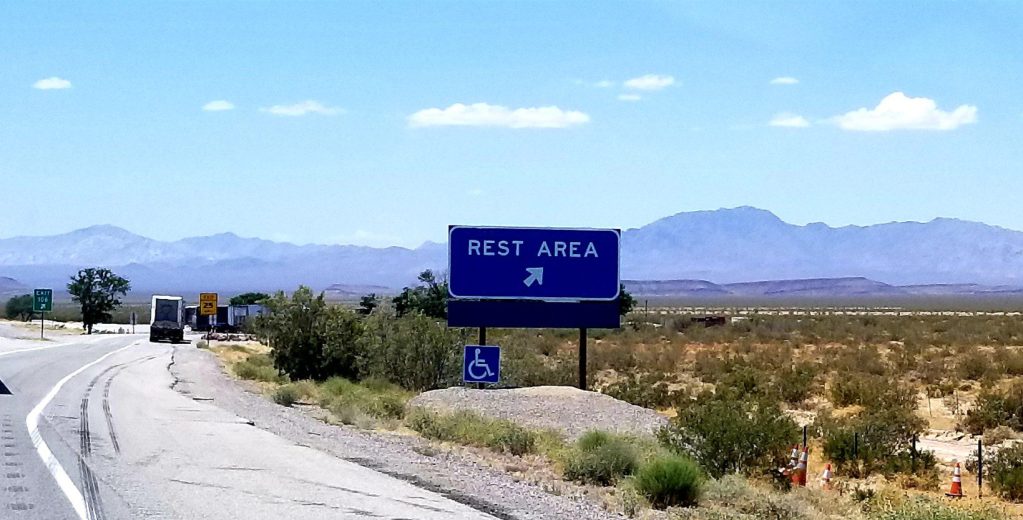
Tips for Interstate Towing
Whether you’re a novice or experienced RV, we have a handful of tips for interstate towing. Let’s dive in!
Use a Weight Distribution Hitch
If you’re towing a travel trailer, a weight-distribution hitch can significantly improve your towing experience. A weight distribution hitch helps equalize the weight between your trailer and truck to improve the balance. If you notice a generous amount of squat in your truck or trailer sway while towing, a weight-distribution hitch can help you.
A weight distribution hitch needs adjusting for your truck and trailer combination. Minor adjustments can make a considerable impact on towing. If you’re purchasing your hitch from a dealer, they’ll likely install and adjust your hitch for you.
Pro Tip : Here’s all the info you need to know about getting a weight distribution hitch for your trailer.
Use Extended Mirrors
Seeing what is going on behind you is essential when towing, especially during interstate towing. You’re able to keep an eye on the traffic around you and any potential issues that could arise with your trailer.
If your tow vehicle does not have extendable mirrors, there are plenty of after-market accessories to help improve your vision while towing.
Keep in mind : These extended mirrors are pretty inexpensive (under $20) and can save you a lot of money!
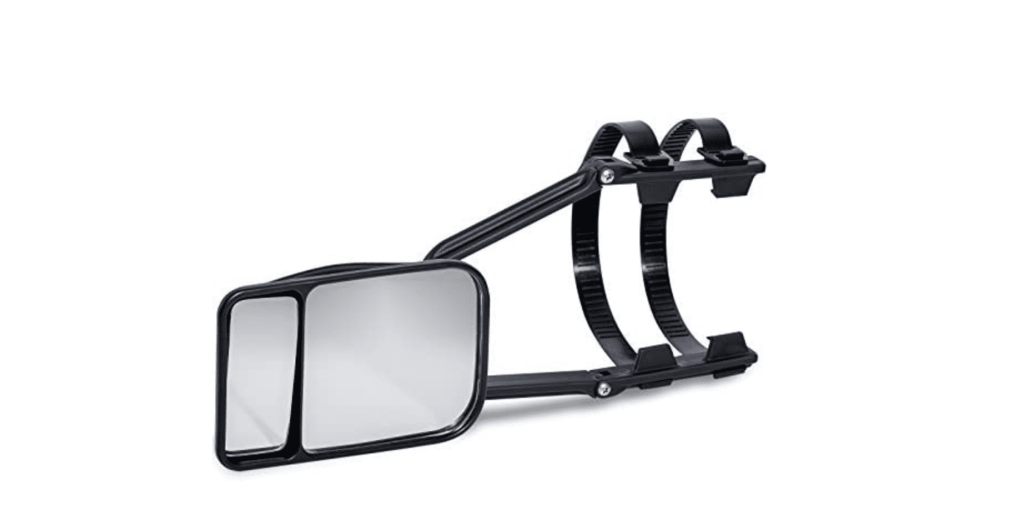
Don’t Feel Obligated To Drive Fast
It’s easy to get caught up in traffic and adjust your speed to the flow of traffic. Just because everyone around you is driving fast, it doesn’t mean you have to as well. Increased speeds while towing are often a major cause of tire blowouts. These blowouts can cause massive amounts of damage.
Driving too fast is a recipe for disaster, whether it’s blown tires or losing control. Don’t let others dictate your speed while towing. Make sure to drive at a safe speed for your RV and the weather conditions. Arriving safely is better than being in an accident for going too fast.
Pack Your Trailer Properly
Many RVers overlook how they pack their trailer. You want to make sure you’re equally distributing the weight between your RV and tow vehicle. Putting more weight towards the front of your RV will put more weight on the hitch. Too much weight on the hitch, and you’ll lose traction from your front tires. However, too much weight on the rear of your RV, and you’ll be susceptible to trailer sway.
Some RVers also forget that a trailer does not have an unlimited carrying capacity. You may have to leave some things at home to avoid putting too much strain on your RV’s axles and wheels.
There are smart scales that can help RVers know how they distribute the weight of items in their RV. Driving your rig across a CAT Scale is also a great way to see where you stand in terms of weight with your RV.
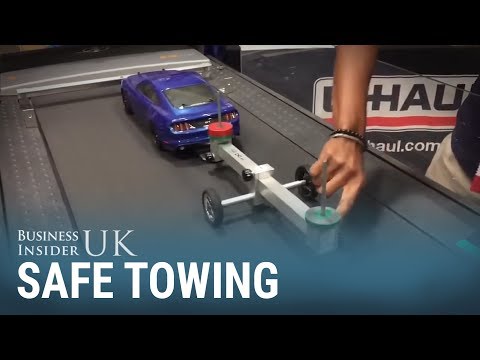
Interstate Towing is Easier with Time
Whether you’re new to towing or not, interstate towing can be intimidating. The great news is that it gets easier the more you do it. So why are you waiting? Go hitch up and hit the interstate for your next adventure! What interstate is your favorite for towing your RV?
Discover the Best Free Camping Across the USA
To be honest with you, we hate paying for camping . There are so many free campsites in America (with complete privacy).
You should give it a try!
As a matter of fact, these free campsites are yours. Every time you pay federal taxes, you’re contributing to these lands.
Become a FREE CAMPING INSIDER and join the 100,000 campers who love to score the best site!
We’ll send you the 50 Best Free Campsites in the USA (one per state). Access the list by submitting your email below:
Two to thee hundred miles per day? Tats halfa day. More like four to five hundred.
Some Interstates are in bad condition. I recently drove I10 from Phoenix to Baton Rouge. It had some very rough spots with major potholes. Another factor to consider is boredom. Interstates are good for making time but not so good for getting a sense of local color. We are about to embark on an open-ended trip through the west and will try to stay on “blue highways” as much as possible.
Been driving 21 years in a Class A on Interstates and back highways. For time, Interstates are best. For scenery, federal and sometimes state highways are best. Avoid county roads! Just finished a 4,000+ mile trip. First half was non-interstate. Really great. No semis, minimum traffic. Had to turnaround on a few County roads. Don’t trust Maps!
re: speed. I rarely drive over 55 on the interstates when towing. Yeah, I get a few nasty “salutes” on occasion, but my fuel, my choice.
It is important to note that large trucks and vans overtaking your vehicle at a much greater speed can severely buffet your RV. Also it may be necessary to check weather conditions and high wind warnings.

- Find a Location
How To Safely Tow a Travel Trailer

With the right preparation, towing doesn’t have to be a stressful part of owning a travel trailer, but a lack of preparation can have disastrous consequences. There is a lot to be aware of if you’re new to towing a travel trailer.
For starters, familiarize yourself with towing terminology that’ll help you determine how much weight your tow vehicle can handle. You might also find our guide to towing with a mid-size SUV useful.
All drivers of towable campers (even those with smaller campers like the Happier Camper ) must be aware of and avoid bridges with low clearance, tight turns, fast food drive-thrus, and, perhaps the most dangerous thing of all, other drivers.
Knowing how to safely tow a travel trailer protects you, your investment, and others on the road. So let’s talk about everything you need to know to tow safely!
Getting Your Trailer Ready for Safe Towing

Your first order of business starts well before you climb behind the wheel. Be sure your vehicle is capable of towing the full payload of your trailer (i.e. loaded weight). Use our towing guide to double-check your math before you hitch up your trailer.
Once you’re sure your vehicle is capable, securely connect the trailer’s tongue to your vehicle’s hitch ball. Double-check all of your turn signals, running lights, brake lights, and hazard signals. You may need a spotter to help you with this.
Also, consider installing a weight-distribution hitch to minimize bounce and sway that can cause you to lose control of your vehicle. These hitches distribute weight to the front axle of your tow vehicle and help to level your payload.
Towing with a high tongue or high rear bumper is never as safe as towing a trailer that is level with your tow vehicle. Consult this video to learn more about how to adjust a weight-distribution hitch.
Also, check tire air pressure and adjust according to your manufacturer’s recommendations. Towing with under or over-inflated tires increases your odds of suffering a blowout and under-inflated tires also reduce your fuel economy.
Becoming Aware of Your Trailer’s Size
Odds are, your trailer is wider than your tow vehicle. That’s why travel trailer owners use mirror extenders to help them check traffic when changing lanes or making turns. This is always a wise investment to help you tow safely.
In addition to the extra width, you also need to get used to the length and height of your trailer. If you’re new to towing, take your trailer to an empty parking lot to practice before you hit the open road.
Practice Towing

Ideally, find a lot with a few light poles scattered throughout so you can practice navigating around and between them. Swing wide when making turns with a trailer behind you. The arc of your trailer’s rear bumper will be smaller than the arc of your tow vehicle’s front bumper.
Pay close attention to how your trailer follows your tow vehicle and observe how wide you need to swing when turning around obstacles. Go slow as you’re practicing and be aware of the lean of your trailer when you turn.
Street signs and traffic signals sometimes hang over the roadway. So being aware of how much your trailer leans in turns will help you avoid these nuisance obstacles. Also, practice pulling into parking spots and work on your reverse skills. It’s helpful to practice backing your trailer up several times before many watchful eyes are on you at an RV park .
A Note on Travel Trailer Height

If you don’t know it off the top of your head, measure the height of your trailer or find it in your owner’s manual. Post that height on a sticky note somewhere you can see it while driving. That will remind you how much clearance you need when going under bridges and overpasses.
To avoid height issues altogether, map out your route before you leave for your next camping adventure. Use an RV-specific GPS system to make sure there aren’t any height restrictions on your desired route. This will help you avoid detours that add hours to your driving time.
Following Road Etiquette Driving a Travel Trailer

There are many RV rules, regulations, and road restrictions to be aware of before setting out. Here is a quick summary of general travel trailer etiquette to follow when towing:
- Use the right lanes unless turning, passing, or entering or exiting a roadway
- If you’re brand new to towing, avoid passing until you feel more comfortable
- On roads with no passing lane, pull over and allow vehicles to pass if there are four or more following closely behind you
- Signal turns and lane shifts early to alert other drivers
- Follow all posted speed limits and traffic signals
Using Appropriate Speeds

Driving at appropriate speeds goes a long way towards safe towing. Reduce your normal speed by 10 to 20 miles per hour when towing a travel trailer. That means doing 60 instead of 70 on major highways and reducing your speed even further on smaller, windier roads.
The tires on most travel trailers are rated for 60 to 65 miles per hour. The silver lining to this is that traveling between 55 and 65 miles per hour will improve your fuel economy, especially when traveling long distances.
And there’s another benefit of slowing down while towing a travel trailer. It will reduce how much all of your camping gear shifts from the time you leave your house to the time you reach your camping destinations .
Abrupt starts and stops are apt to cause your gear to move around in your trailer. This can cause damage to your gear and your trailer itself. Towing more slowly helps to ensure that you arrive with everything in the same condition it was in when you left.
Slowing Your Travel Trailer Down
Using appropriate speeds also comes into play when slowing your trailer down. Your vehicle and trailer need two to three times more distance to slow down and stop than your vehicle on its own.
The faster you go, the longer (and further) it will take to slow down. This is true even for travel trailers with electronic brake controllers , which take some burden off your tow vehicle’s brakes.
What To Do When It Gets Windy

The wind is one of the trickiest factors when towing a travel trailer. You are basically driving a large sail down the road and, unfortunately, it will be affected by wind much more than your tow vehicle.
A crosswind is more dangerous than a headwind or tailwind. When you feel the wind pushing you left or right as you drive, you will need to steer into it gently to keep going straight. Depending on the size of your trailer, even minor crosswinds of 10 to 15 miles per hour can impact your steering.
Heed all posted wind warnings along your driving route. If a posted recommendation suggests doing so, or you feel uncomfortable continuing to drive, pull over and wait until conditions improve.
Tips for Driving in Inclement Weather

In addition to the wind, driving in inclement weather must be approached with caution. Rain, snow , ice, fog, and other environmental factors should make you pause and think twice about continuing your journey.
Use your preferred weather app to check the weather early and often along your route. Just like the wind, it’s better to pull off and wait for a storm to pass than to continue driving into unsafe conditions. If you do pull off, some of these tips for staying entertained when the weather turns bad may prove useful.
Also, tune into AM radio stations broadcasting road alerts and weather warnings along your route. As a good rule, if the lights on those road condition signs are flashing, tune into the advertised station to learn why.
Handling The “Pull” of Large Vehicles

In addition to the wind, you will contend with the pull of RVs , semi-trucks, fifth wheels , and any other large vehicle you pass. This happens when two large vehicles are moving in opposite directions and the effect is greatest on two-lane roads without a center median.
As a driver, you’ll feel your tow vehicle and trailer pulled towards oncoming traffic. To be clear, you DO NOT need to overcorrect in this scenario. On calm days, slightly steering away from oncoming traffic will suffice, but you will need to gently correct once the vehicle has passed.
This effect increases in windy conditions. If you’re dealing with a crosswind from left to right, for example, you’ll already be steering slightly towards oncoming traffic to keep your trailer straight.
When a semi-truck passes, it acts as a momentary windbreak. To correct, you’ll need to gently reduce how much you’re steering into the wind and then correct once the truck passes.
This effect can be very subtle and may not require major corrections in the orientation of your steering wheel. Reducing your speed can also minimize the impact of pull when passing large trucks and other RVs. If at any time you feel unsafe on the road, then pull over and take a break.
Navigating Steep Mountain Grades

There are two main issues when navigating steep mountain grades . When descending, be conscious of burning up your vehicle and trailer brakes and, when ascending, engine overheating is a concern.
If you are towing a travel trailer up steep mountain grades, you must accept that you will go much slower than normal. If you’re well below the posted speed limit, move to the furthest lane to the right and consider turning on your hazard signals to warn other drivers.
Taking your time is recommended on steep inclines because it lessens the strain on your engine, drivetrain, and transmission. On long mountain grades, you may need to pull over at regular intervals to allow your engine to cool. Keep an eye on your engine temperature gauge and pull over if engine temp starts to rise.
Coming Back Down
When descending steep mountain grades, use your transmission to assist the braking systems on your tow vehicle and trailer. This is also when you can engage your electronic brake controller to reduce the stress on your vehicle’s brakes.
It’s a good practice to downshift early and prevent your trailer from reaching high speeds in the first place. It’s smart to maintain a slower average speed than allowing your trailer to speed up dangerously. The latter puts unnecessary stress on your braking systems to slow you back down to a reasonable speed.
Also, you never want to ride your brakes for a long period of time on a descent. Depress them to bring your speed well below the posted limit and then let off again. Continuous application of brakes is what burns them up.
Planning Gas Stops

Even getting gas, which is normally quite simple, can be challenging when towing a travel trailer. Plan your gas stops further in advance to avoid stations that can’t be navigated by larger vehicles.
Finding big rig friendly gas stations is imperative on your travels. Travel centers and truck stops along major highways won’t be hard to find, but you can use The Good Sam Trip Planner to find navigable gas stations in more remote locations too.
Be Proactive, Not Reactive

As a final word, always practice smart, mindful driving techniques when towing a travel trailer. It takes longer to execute all driving maneuvers in a travel trailer. Keep a watchful eye for other drivers and start moving over a few miles before your next highway exit.
It’s always safer to pass a highway exit, for example, than to make a quick, last-minute maneuver in an attempt to exit. There is always another exit ahead and a slight delay is better than the alternative.
With the right preparation, a little practice, and diligence on the road, you’ll be safe towing your travel trailer wherever you want to go. If you want some travel ideas, check out these seven romantic campgrounds calling for a couple’s getaway !
What tips do you have for towing a travel trailer? Leave a comment below!

- Comment (4)
If your tow vehicle is not already equipped, you should also invest in a good set of outside mirror extensions. It is vital you see beyond the width of your trailer.
I like your advice to go wide and slow while turning. My sister and her husband want to buy an RV travel trailer. I’ll share this advice to help them stay safe!
Great topic. I saw pictures of travelers with caravan on worldee. Its a inspiration for me. I think its better than flying…
Excellent article, great info
Leave Your Comment Cancel Reply
Save my name, email, and website in this browser for the next time I comment.
Shop By RV Type

Your Adventure Awaits
Copyright © 2023 cwi, llc all rights reserved.
- RV Glossary |
- Privacy Policy |
- California Privacy Rights |
- Do Not Sell or Share My Personal Information |
- Targeted Advertising Opt Out |
- Terms of Use
- Skip to primary navigation
- Skip to main content
- Skip to primary sidebar
- Skip to footer
Journey With Confidence
What Are Safe RV Towing Speeds?
- RV Lifestyle
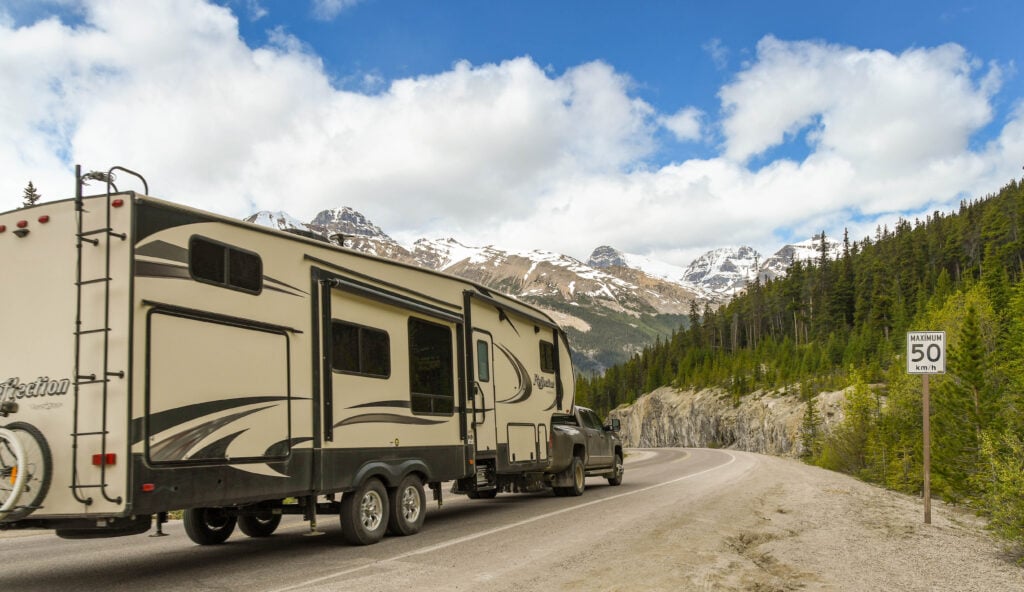
There’s a lot to know when it comes to RV towing. Whether you’re towing a bumper-pull or fifth wheel with a truck, or you’re pulling a little tow car behind a motorhome, knowing the ropes before you hit the road is important. Weight limits , how to hitch up , and how to avoid low-clearance bridges are some of the things newbies need to know.
Another biggie? Safe RV towing speeds.
How fast you’re going can completely change how things go should a high wind catch you by surprise, or should somebody cut you off. Therefore, learning about safe RV towing speeds should be at the top of your list before your first trip.
Lucky for you, that’s exactly what we’re going to discuss below.
How fast can I go when towing or driving an RV?
Let’s jump right in by answering that burning question: How fast can you safely go while towing or driving an RV? Honestly, the answer to this depends on a lot of factors.
In ideal conditions and barring any local speed limits saying otherwise, the fastest you should find yourself towing a bumper-pull, fifth wheel, or car on a dolly or trailer is between 55 and 60 mph, and many choose to keep the speedometer around 50. Meanwhile, most experts recommend you never flat tow a car faster than 55 mph.
Driving a motorhome without a tow car? In that case, you can probably go a little faster, but 60 to 65 mph should still be your max speed.
Why do I need to drive my RV slowly?
Wondering why you need to drive slower in an RV? There are actually several reasons why slower RV towing speeds are safer.
Stopping a big vehicle takes more time
The bigger your rig is, the heavier it is, and the heavier your rig is, the longer it will take to stop. Driving faster makes it even more difficult to stop quickly, meaning a slow driver is going to be much better off should traffic come to a sudden halt.
Turning a big rig is more difficult
Turning an RV takes some getting used to. It requires that you swing wide and calculate things just right. This is much easier to do if you give yourself time to think and take your turns slowly. Not only will this help you ensure you get those turns right, it’ll also reduce the amount of damage you do if you get one wrong.
Going too fast can cause sway
When towing a bumper-pull or a car on a trailer, driving fast can lead to the trailer swaying back and forth. If this sway gets too rough, it can actually take control of your vehicle, swinging you back and forth, and potentially even causing your tow vehicle to spin.
Obviously, this is very dangerous and is something you want to prevent. Driving slowly is one of the best ways to prevent sway.
Driving uphill too fast can cause engine damage
Planning on driving through the mountains? Plan to go slow. Attempting to drive a big rig uphill fast can cause damage to the engine of your vehicle, leading to costly repairs and leaving you stranded on the side of the road.
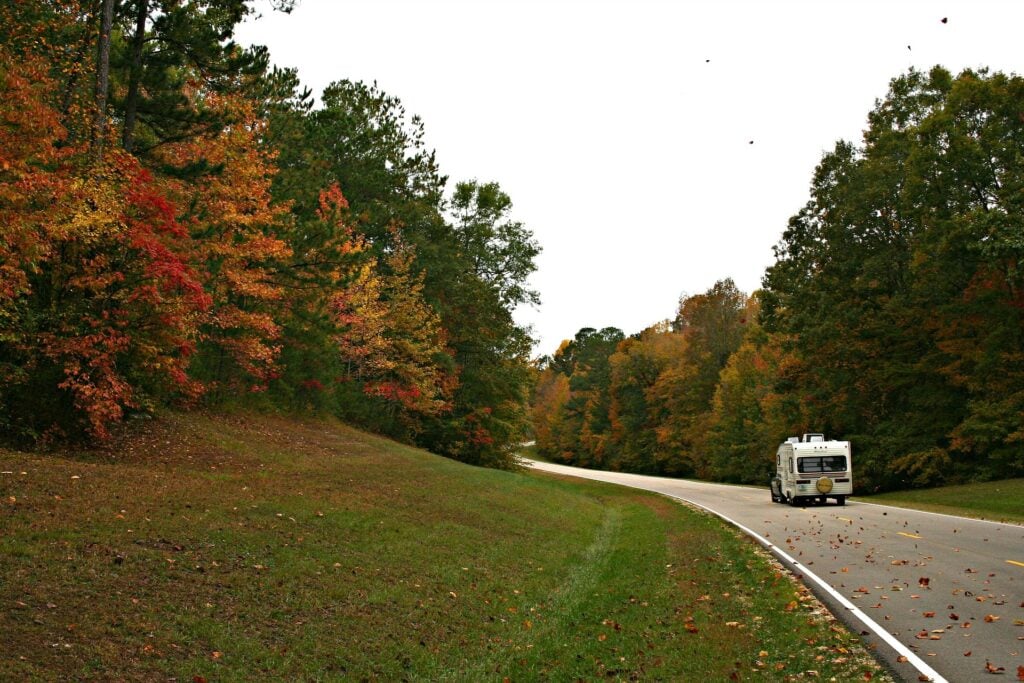
When should you slow down in an RV?
Not only should you stick to the speeds mentioned above in ideal conditions, there are actually other factors that can require you to slow down even more. Pay attention when RV towing, and if one or more of these factors come into play, adjust your speed accordingly.
Lower legal speed limit
Obviously, you do have to mind the legal speed limits in any given area. Watch for truck-specific speed limits, as these apply to RVs as well. Additionally, know that some states have speed limits that apply specifically to those who are towing, so be sure to look up these limits before hitting the road.
Windy conditions can be extremely dangerous, especially for tall, top-heavy RVs. If you feel your trailer swaying in the wind, or if the wind feels like it’s causing your motorhome to be out of control, slow down. Still an issue? Stop and stay put until the windy weather passes.
Poor visibility
Another weather issue that can make driving an RV unsafe is rain or fog that causes poor visibility. If you’re finding it difficult to see while driving your RV, slow down and turn on your headlights. Depending on the situation, you might even consider pulling over until things clear up.
As mentioned above, driving fast up an incline can cause damage to your vehicle. Not only that, many trucks and motorhomes simply won’t be able to pull all that weight uphill even if you tried to gun it.
Plan to slow down on inclines, and know that your travel day will likely be longer than your GPS predicts. (As longtime RVers well know, it usually is anyway).
Other RV towing tips
Now that you know how what you can expect in terms of RV towing speeds, let’s touch on a few other RV towing tips.
Know your weight limits
First, make sure you know how much weight your RV can hold, how much your truck can tow, and the other weight limits of your rig. Watch the weight of your setup and make sure you stay well within these limits.
Invest in towing mirrors
If you’re towing a fifth wheel or bumper-pull, you will likely want to invest in special towing mirrors for your truck. These will help ensure you can see beside and behind your rig while towing.
Ensure you have trailer brakes
Trailer brakes are incredibly important. If you don’t have them, get some. Make sure they are installed and calibrated correctly, and know how to use them in case of emergency.
Never ride in a trailer or towed vehicle
We’d also like to remind you that people and pets should never ride in a trailer or towed vehicle. Doing so is extremely dangerous and not worth the hazard it poses.
Use an RV-safe GPS
Driving or towing an RV is different. You can’t drive as far, as long, or as fast. Knowing where you need to stop at the end of the day is a challenge, unless you have RV LIFE Trip Wizard . The unique Driving Radius provided by RV LIFE Trip Wizard shows you exactly where to stop and find a campground or RV park, based on criteria you have set. Plan ahead, plan smart, and know exactly where to stop.

Towing Tips
Tips for towing on the highway.
Towing a trailer requires care and responsibility from the moment you start inspecting your trailer through to loading it and pulling out onto the road until you arrive at your destination. However, when you’re towing a trailer on the highway–especially when your trip covers long distances–you need to be extra cautious and follow all the rules of the road to ensure a safe trip from start to finish.
Know the Towing Laws
First, be aware of your state and local towing laws, as well as the towing laws of any other states you may be traveling through. For example, your state’s maximum towing speed may be different from that of the state you’re traveling to. In addition, some states may also have a law regarding the maximum trailer width or maximum weight you are allowed to tow, and some require you to stay in the right-hand lane at all times. Be sure to check in all locations your travels may take you through to ensure you’re following abiding by the laws in place.
Prepping and Loading Your Trailer
Another crucial step in towing a trailer safely on the highway that takes place before you hit the road is prepping and inspecting your trailer. You must ensure your trailer is ready for the long haul, and that includes checking parts like lug nuts, tires, your coupler, and more to get your trailer ready for a safe trip. This also includes loading your trailer properly as this will help keep your cargo safe and secure for the duration of your trip.
On the Road
Once you’ve carefully inspected your trailer and have loaded it correctly, it’s time to hit the road. First, we recommend maintaining a speed limit of 55 miles per hour or less. Driving too fast can contribute to issues like trailer sway and combination disturbance , which can be dangerous not only for you but also other drivers and passengers on the road. Only pass others when you can do so safely without exceeding the recommended speed limit, so long as it is legal. Never exceed the posted speed limit while towing.
Beyond your speed, there are several other points to keep in mind when towing on the highway so you can have a safe trip. Remember to:
- Plan stops for resting. Avoid towing when you are tired and at night.
- Inspect your vehicle and trailer connections at each stop.
- After 10 miles, retighten lug nuts, check tire pressure, and make sure couplers are secured. Do this again after 25 miles.
- After 50 miles, make sure the coupler and cargo are secured and that the safety chains are fastened and not dragging the ground.
- Anticipate stops and brake early.
- Don’t use cruise control.
- If a wheel goes off the pavement, ease off the gas pedal and decrease to a speed below 25 miles per hour. Gradually steer back onto the road.
Anytime you are towing a trailer you should do so with care. Remember to consult your owner’s manual for specific recommendations for your trailer. You can also refer to our Pre-Departure Checklist , Guide to Towing , and Vimeo channel for additional tips and information.
Related Articles

WHAT IS THE BEST MAINTENANCE SCHEDULE FOR MY TRAILER?
Safer towing is more than just knowing how to properly load and haul your trailer. Proper trailer maintenance is a must, so it’s important
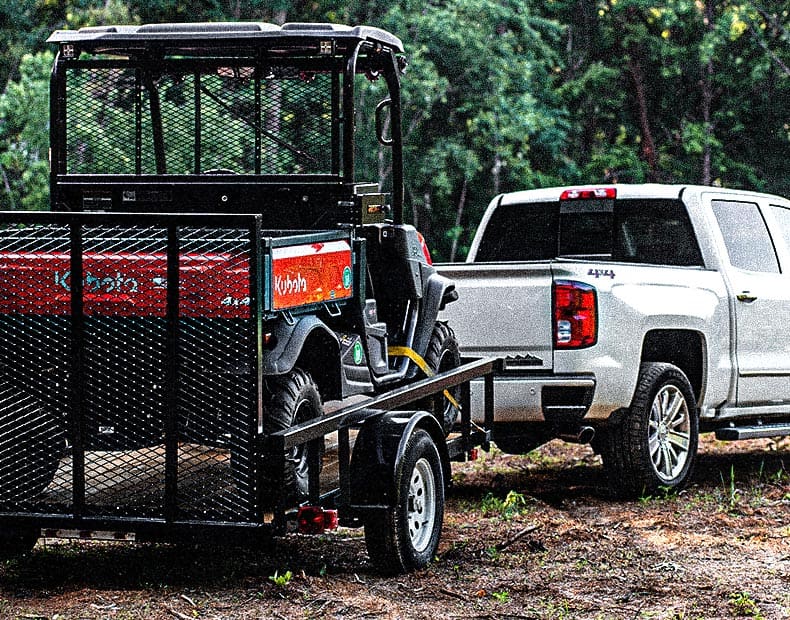
USE PROPER TOWING ETIQUETTE EACH TIME YOU HAUL YOUR TRAILER
You can’t treat towing a trailer the same as if you were just driving your car or truck on the road. With the added load comes...
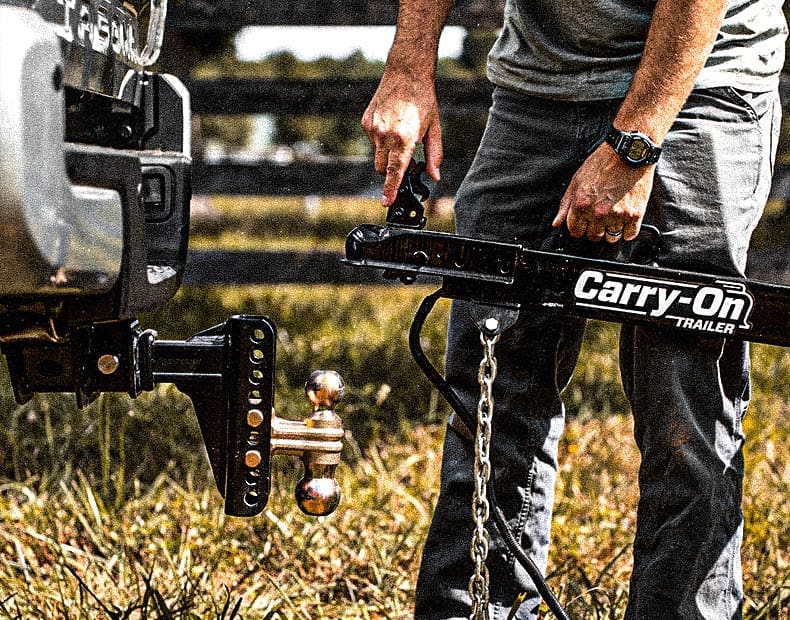
HOW TO HITCH YOUR TRAILER
When you’re getting ready to tow your trailer, whether it’s to haul a load across your property or across town, there are many...
Sold nationwide in stores near you.
Customer Service

*Made in the USA with foreign and domestically sourced materials.
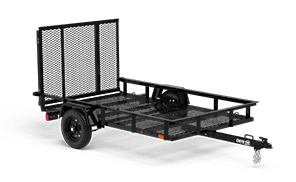
Equipment & Car Hauler
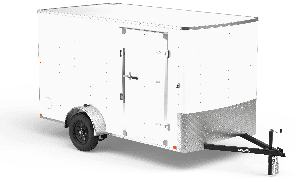
Enclosed Cargo
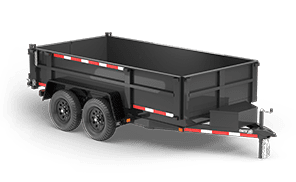
Dump Trailer
State Regulations Regarding Travel Trailers and Driving Laws
Natasha Japp Photography/Getty Images
If you plan to drive your RV or trailer on a state by state camping road trip , you'll want to know the laws of each state. We RVers go to great lengths to choose an RV that meets our needs and budget. We learn to drive or tow them with care. We insure them, make sure they’re registered and that we’re abiding by all the laws.
But one thing most of us don’t give much thought to is that when we cross a state line not only might the traffic and driving laws be different than in our home states, but the legal specifications for our RVs might be different, as well. These tips on regulations for RV laws and trailer by the state are intended to be helpful, but regulations change often and it is up to you to know and follow the law.
Some General Differences in State Driving Laws
In California , the speed limit on freeways is 55 mph for any vehicle towing a trailer and 70 without a trailer.
In New Jersey, if you are pulled over and found to have a firearm that was not purchased IN New Jersey, you are breaking the law.
The speed limit maximum in Texas is 70 mph during the day, and 65 at night. If you don’t take notice of this they will ticket you. It’s easy to do when leaving a state like Colorado where the speed limit maximum is 75 mph. I was pulled over in Texas one morning for going 72 mph.
New York doesn’t allow trailers at all on most parkways.
Some states don’t allow right turns on red lights, anywhere. Others allow them as a rule, and with only specific streets restricted.
Most speed laws become immediately apparent because they are usually posted prominently along the highways. But the right turn, towing regulations, propane limitations, and other types of laws are harder to know, because those are in the drivers’ handbook, but not necessarily posted so that out-of-state drivers would be aware of them.
But these aren’t the only differences in highway laws that can get you a citation and a fine.
Width Limits
Our older Airstream is only 8 feet wide. But newer ones are 8 feet 5.5 inches. But, did you know that these newer Airstreams are illegal, by a mere 5.5 inches, on highways in some states?
Alabama, Arizona, Washington D.C., Georgia, Illinois, Kentucky, Louisiana, Michigan, Missouri, New Hampshire, New Jersey, New Mexico, New York, Oklahoma, and Tennessee each have a width restriction for trailers of 8 feet.
In Connecticut width for RVs is limited to 7.5 feet, 8 feet high, length 24 feet and weight 7,300 pounds on the Merritt and Wilbur Parkways.
Length Limits
Alabama, in addition to having an 8-foot width limit also has a trailer limit of 40 feet.
If you plan to tow a trailer and a boat, or any combination of two tows, stay out of California.
Contrary to California, Arizona allows, with some restrictions, more than one trailer.
Trailers are limited to 32 feet on Mississippi’s Natchez Trace.
Brakes, Hitches
Several states have trailer brake and hitch requirements. Iowa requires equalizing hitches, sway control and brakes on all trailers over 3,000 pounds.
Minnesota requires trailers of 6,000 pounds or more to have breakaway brakes.
North Carolina requires an independent brake system for house trailers of 1,000 pounds or more.
Utah requires breakaway braking system if over 3,000 pounds.
Other Restrictions
If you’re traveling from Illinois to Iowa, route around the bridge between Fulton, IL, and Clinton, IA. Trailers are prohibited on that bridge.
If you have propane tanks (don’t we all?) you cannot pass through the Baltimore Harbor Tunnel or Fort McHenry Tunnel in Maryland.
If you’re planning a trip to Montana’s , find out what RV restrictions are in place first.
In Virginia, you’re limited to two portable bottled gas tanks of 45 pounds with valves closed in the Hampton Roads Bridge Tunnel, Chesapeake Bay Bridge Tunnel and the Norfolk-Portsmouth Tunnel.
And Wisconsin, under limited conditions allows riding in a fifth wheel.
Sorting It All Out
Planning a cross-country trip could be more work than you’d originally planned to do if you want to stay street-legal in all the states you’ll be traveling through. To be sure, look up the department of motor vehicles websites in the states you plan to travel through. Most have a way to apply for a permit or waiver if your rig doesn’t meet their laws. Having these on file as you travel through each state will make your trip go more smoothly. It is also good to know whether there are no waivers, too, so you can reroute your trip.
Driving in Arizona
How to RV in New York City
Driving in Paris, France
Great Basin National Park: The Complete Guide
A State-by-State Guide to Driving in Campers
Driving in Spain
Everything You Need to Know for Your First Campervan Trip
RV Camping at Yosemite: What You Need to Know
Yosemite National Park: The Complete Guide
Driving in Scandinavia
10 Safety Tips for Planning an RV Trip
Driving in New York
Driving in Newfoundland, Canada
Driving in Germany
Driving in Canada
Driving in Israel

What Speed Limit When Towing? Trailer Towing Speed Limits By State
When towing a trailer, it is important to obey the speed limit to ensure the safety of you and other vehicles on the road. This will ensure that you drive safely and avoid any potential accidents.
In this guide, we’ll cover the speed limit when towing a trailer, trailer towing speed limits by state, and how to stay safe while driving.
What’s The Speed Limit When Towing A Trailer?
In general, the speed limit when towing a trailer is about 10 miles per hour less than the regular posted speed limit.
This usually translates to about a 55 mph max towing speed limit on highways in most States.
Just like driving any other vehicle, each road is going to have a posted speed limit, which you should always follow.
But what about highways where the speed limit could be as high as 70 or even 80 mph in some States?
It’s not wise to tow a trailer at such high speeds.
Doing so can increase trailer sway, which can put you, others, and your towed property at risk of a collision.
There are specific requirements that each State has in place, so you’ll need to be aware of them when towing in your home State as well as across State lines.
Trailer Towing Speed Limits By State
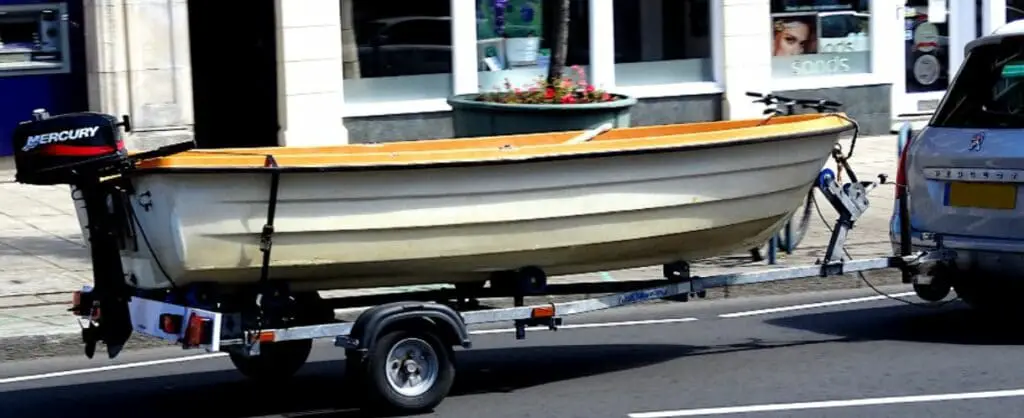
We’ll jump into each State’s towing speed limits next.
Before we do, it’s important to understand that there are specific designations for towing speed limits, and those can vary from travel trailers, cargo trailers, and RVs, so pay attention to which rules apply to you.
Below, we’ll list out the towing speed limits for each State, as well as any additional remarks they have regarding towing and speed limits that the State has commented on for extra context.
We’ll also list out any additional relevant towing rules or regulations for extra reference.
In addition to following these speed limits, you should always practice general towing safety .
Towing Speed Limit: 55 mph, must be reasonable and proper.
RVs are required to keep headlights on when towing.
Towing Speed Limit: 55 mph.
Maximum towing speed while towing a mobile home is 45 mph.
RVs are required to carry reflective signs or flares, as well as fire extinguishers and a gas detector.
Towing Speed Limit: 65 mph.
Vehicles towing trailers or semitrailers may not exceed a rate of speed that causes lateral sway.
Triple towing is allowed with a fifth wheel.
Speed limits are 70 mph on rural interstates and 55 mph on urban freeways or as posted.
Overnight parking in rest areas is allowed unless otherwise posted.
Maximum speed for any vehicle towing another vehicle is 55 mph.
Vehicles towing in California must use the right-hand lane only.
Towing two trailers at once is allowed in Colorado.
Connecticut
RVs are forbidden from using carpool lanes in Connecticut.
No trailer carrying a gross weight (GW) load in combination with a vehicle in excess of 4,000 lbs can go over 10mph unless equipped with trailer brakes.
You need to use two methods of applying vehicle and trailer brakes in Delaware.
District of Columbia
The maximum RV width is 8 feet in D.C..
Speed limit is 30mph in business and residential districts, 55mph at all other locations besides highways where it’s 65mph (unless otherwise posted).
Double and/or triple towing is not allowed in Florida.
Towing Speed Limit: 65 mph or as posted.
You cannot park overnight at rest areas in Georgia.
Towing Speed Limit: 55 mph or as posted.
The maximum allowable trailer length in Hawaii is 48 feet.
Idaho allows passengers to ride inside truck campers.
Trailers are not allowed on boulevards around or inside Chicago.
The maximum allowable motorhome length in Indiana is 45 feet.
Iowa allows passengers to ride in pickup campers, travel trailers, and fifth wheels.
The max allowable trailer and RV height in Kansas is 14 feet.
Kentucky does not require trailer brakes for passenger car trailers at any weight.
Boat or utility trailers have the same speed limits as passenger cars.
House trailers are limited to 55 mph during the day and 50mph at night for brake-equipped trailers between 15’-32’ long.
50 mph speed limit for trailers without brakes that are less than 15’.
All others have a 45 mph speed limit.
Passengers are allowed to ride in pickup campers.
Maine allows single trailer towing only, no double or triple towing.
Maine does not allow liquid propane gas in some tunnels on I-95.
Massachusetts
Trailers are not permitted on many Boston parkways.
Trailer tires must have a minimum tread depth of 2/32” in Michigan.
Triple towing is allowed in Minnesota if it is a fifth wheel combined with a watercraft, ATV, snowmobile, or motorcycle.
Mississippi
Passengers are forbidden from riding in travel trailers, fifth wheels or pickup campers in Mississippi.
Missouri requires brake systems on 5th wheel trailers only.
Every RV is required to carry reflective signs or flares in Montana.
Every RV is required to carry reflective signs or flares in Nebraska.
Motorhome speed limit is 50 mph.
Drivers and passengers cannot have open alcoholic beverage containers inside the tow vehicle, but are allowed inside the motorhome or travel trailer living areas.
New Hampshire
House Trailer Speed Limit: 45 mph.
You are not allowed to park overnight at rest areas in New Hampshire.
Open propane cylinders are forbidden while driving on open highways in New Jersey.
No additional restrictions on cars with trailers.
You can park overnight in New Mexico rest areas, but you can’t park overnight for more than 24 hours in any 3-day period.
You cannot transport liquid propane through any New York tunnel.
North Carolina
North Carolina requires travel trailers weighing 1,000 lbs and over to have an independent brake system.
North Dakota
Towing Speed Limit: 65 mph
Rural interstate: 75 mph, non-interstate multilane highways 70 mph, 2-lane highways 65 mph if posted. If not posted, 55 mph..
Each trailer going 25mph or over must have safety chains attached.
55 mph is the max speed limit for any vehicle or vehicle combination weighing over 8,000 lbs.
Brakes are required if the empty trailer weight exceeds 2,000 lbs.
Maximum travel trailer length must be under 40 feet in Oklahoma.
Any vehicle towing a trailer or camper and any vehicle with a registration weight at or over 8,000 lbs must use the right lane of all roadways with two or more lanes traveling in the same direction.
You cannot pump your own fuel in Oregon.
Pennsylvania
Otherwise, rural interstate highways are 65 mph, residential districts on most local highways 25mph, urban districts 35 mph, and 55 mph in other locations.
All trailers must have trailer brakes.
Rhode Island
You can park overnight in Rhode Island rest areas.
South Carolina
Manufactured or mobile homes have a maximum towing speed limit of 10 mph under the posted speed limit when it’s over 45 mph, and can never exceed 55 mph.
The total length limit of the tow vehicle and trailer combined cannot exceed 60 feet.
South Dakota
65 mph on secondary highways except where posted.
75 mph on interstate except where posted.
All towed vehicles or trailers over 8,000 lbs are required to stop at weigh stations.
Rural interstate 70mph or as posted.
The max trailer width is 8 feet in Tennessee.
Towing Speed Limit: 60 mph during day, 55 mph at night.
You can park in rest areas in Texas for a 24 hour period maximum.
RVs and trailers up to 14 feet tall are allowed in Utah.
Vermont requires all trailers to have a fire extinguisher.
Virginia allows a maximum of two 20 lb propane tanks per travel trailer.
Towing Speed Limit: 60 mph.
You can park for a maximum of eight hours overnight in Washington state rest areas.
West Virginia
You cannot triple tow in West Virginia.
Triple towing in Wisconsin is allowed with a special permit.
You must prove that you can stop in 40 feet while driving 20 mph while towing in Wyoming.
Puerto Rico
Same as passenger cars or according to the zone you’re in.
Max speed for heavy motor vehicles is 10 mph below the speed limit in any zone.
Trailer Towing Speed Limits In Canada By Province
Towing Speed Limit: 100 km/h or as posted.
British Columbia
Towing Speed Limit: 80 km/h on provincial highways. 50 km/h in populated areas, or as posted.
Towing Speed Limit: 90 km/h in rural areas. 50 km/h in urban areas or as posted.
New Brunswick
Towing Speed Limit: 80 km/h or as posted.
Newfoundland and Labrador
Towing Speed Limit: 90 km/h.
Northwest Territories
Towing Speed Limit: 90 km/h or as posted.
Nova Scotia
Towing Speed Limit: Same km/h as passenger cars.
Prince Edward Island
Towing Speed Limit: Same km/h as passenger cars, or as posted.

Saskatchewan
Trailer tire speed ratings.
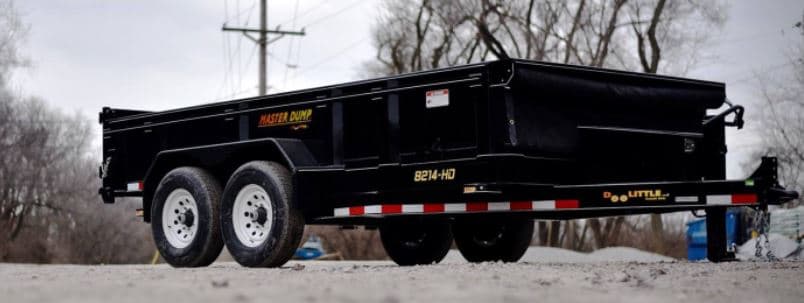
When determining the towing speed limit, you should also be aware of the speed rating of your trailer tires.
This will usually exceed the maximum towing speed limit in whatever State you’re in, which is a good thing.
This does not mean that you should go above the posted speed limits, as they’re there for the safety of you and others.
The trailer tire speed rating is the last letter of the description on the tire’s sidewall, ranging from values of A1-A8, B, C, D, etc, all the way up to ZR.
Most trailer tire speed ratings are valued at G, J, K, or L, and are rated for maximum speeds of 65 mph to 75 mph.
Do not exceed these speeds, as you can damage your tires which can lead to shaking, wobbling, or a collision.
Other Considerations
In addition to following the right speed limit when towing, having the right tire pressure for towing is just as critical.
Be sure to check out our other towing guides for more information while you’re here:
How To Hook Up A Trailer Step-By-Step
Parts Of A Trailer Hitch Diagram
Tow Hitch Receiver Sizes
Leave a Comment Cancel reply
Save my name, email, and website in this browser for the next time I comment.
Terms and Conditions - Privacy Policy

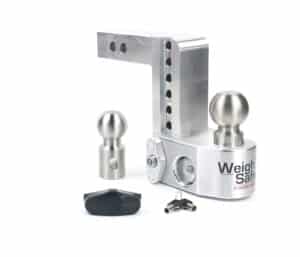
WEIGH SAFE ADJUSTABLE BALL MOUNT
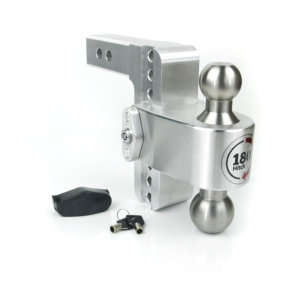
TRUE TOW WEIGHT DISTRIBUTION
Heavyweight, middleweight.
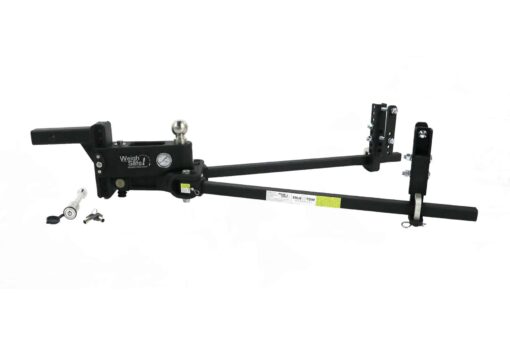
HEAVYWEIGHT - ORIGINAL
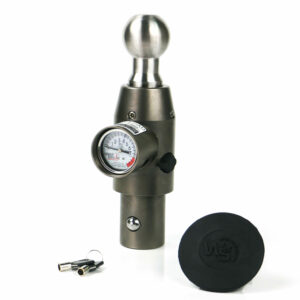
WEIGH SAFE HITCH PIN LOCK
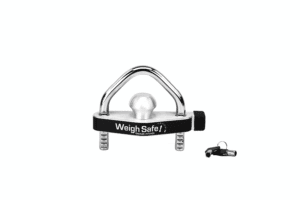
WEIGH SAFE CLAMSHELL CONVERTER
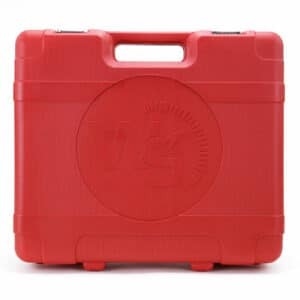
WEIGH SAFE STORAGE CASE
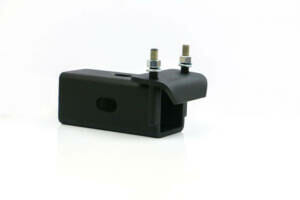
WEIGH SAFE ANTI-RATTLE REDUCER
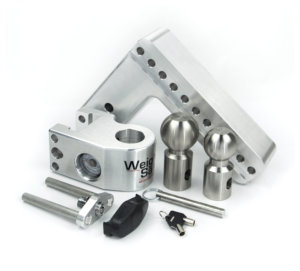
WEIGH SAFE ACCESSORIES & PARTS
- About Weigh Safe
- Brand Ambassador
- Social Media
- Frequently Asked Questions
- Return Policy
- Weigh Safe App
- Dealer Locator
- Authorized MAP Policy
- Become A Dealer
- Dealer Content
- Dealer Portal
- New Dealer Registration
- Unauthorized Dealers
- Search for:
No products in the cart.
Return to shop
Towing Safety
Trailer towing laws: which federal and state regulations apply to you, trailer towing laws, codes, requirements and limitations…ahh …sifting through those feels a bit like reading a long textbook in a foreign language. are we right, but, never fear…your weigh safe team is here to help keep your towing experience legal, safe, and simple..
Did you know that because trailers are attached to your vehicle, their use is governed by the law? Yes, indeed. And, if you are planning to tow a trailer behind your vehicle, you need to be mindful of federal and state laws governing trailer safety and installation requirements.
Why? Because failure to comply with federal and state towing regulations can create a dangerous situation that leads to property damage, personal injuries, and expensive litigation.
Yikes. Have you ever read a state’s legislative code on transportation, entirely? How about all 50 of them? No? What about all of the regulations published by the Federal Motor Carrier Association? If so, give yourself a big round of applause because that’s an insane amount of reading.
Need a place to help you get started?
Ta-da! Meet your summary of federal and state trailer towing requirements. In this guide, we’ll review the most important factors you need to be aware of when it comes to towing a trailer legally, including: registration, insurance, safety equipment, and safety measures. Did we mention that we’ve also included some examples, references, and links to official legislative resources? Oh, yep, we did.
Let’s begin…
Big Factor #1:
Are you hauling materials for personal or commercial use.
Let’s say you have two drivers, each with the exact same truck, trailer, and hitch…towing the exact same kind of landscaping equipment. You may assume that they are liable to comply with the same towing laws and regulations…
But, they aren’t.
You see, one driver is towing privately owned equipment for use at his private property, while the other driver is towing business-owned equipment to a jobsite.
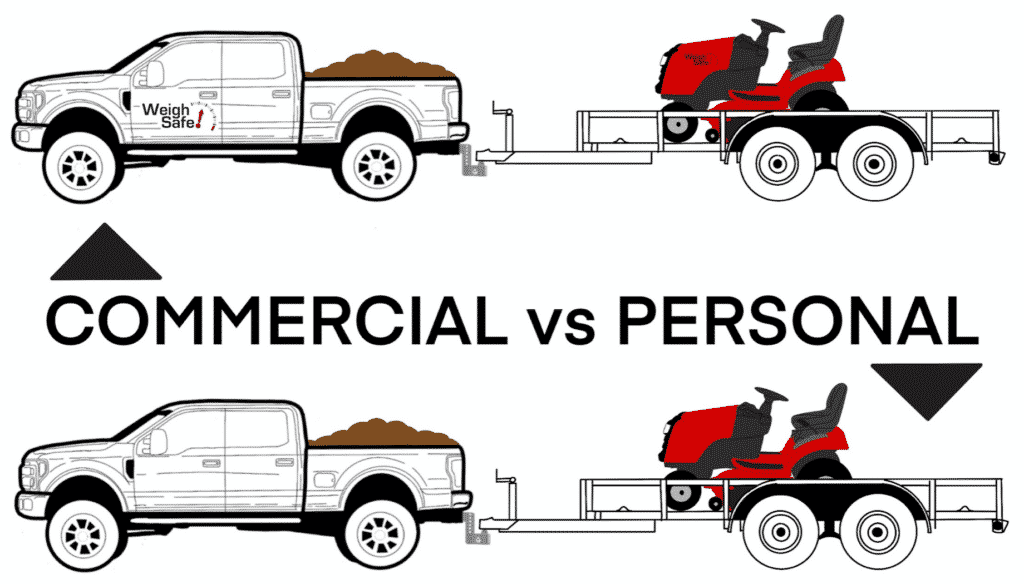
Even though their hitch set-up and load looks identical….
- The business owner towing equipment for commercial use will have more laws and safety regulations to comply with than the driver towing equipment for personal use.
- Federally enforced regulations come into play for the driver who is towing materials for commercial use.
Towing loads for private use
As explained above, if you’re only planning to tow a loaded trailer for private use, you only need to be mindful of your state’s most basic regulations.
State Regulation Basics:
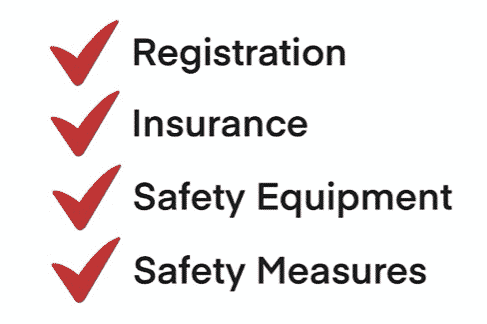
Let’s use an example to help illustrate what this means…
Example #1: Light-duty towing for personal-use in the state of Utah
Let’s say you are living in Utah, and you’ve just purchased a trailer to tow landscaping equipment to and from your house. You’re planning to use your trailer to pick up a stump grinder and a powerized tiller that you’ve rented for leveling out some areas of your yard.
You ask yourself:
“Do I know how to tow this equipment with my new trailer, safely and legally?”…
“Er…..” You realize you don’t know what Utah’s safety regulations are for towing loaded trailers.
So, you head to google… and now, here you are! Ready to follow this easy guide:
MINIMUM REGULATIONS TO COMPLY WITH

REGISTRATION
- For this example scenario, you’d want to start by making sure both your truck and trailer are registered in the state of Utah.
- Every vehicle operated in Utah, including travel and tent trailers, weighing more than 750 lbs, must be titled and registered. Utah’s Division of Motor Vehicles, Trailers
- Check with your state’s DMV to comply with your state’s registration regulations.
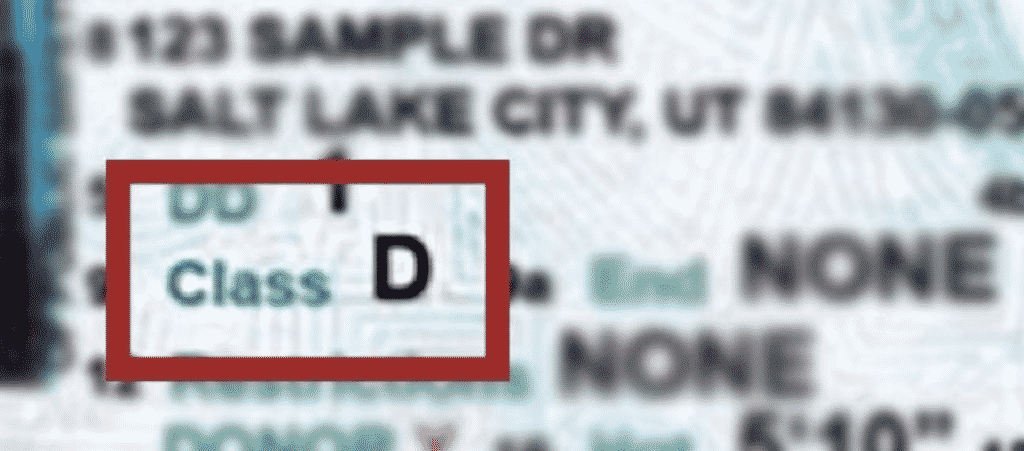
- In this case, you’ll likely be using a light-duty truck and light-duty trailer with a GVW (gross vehicle weight) of under 10,000 lbs.
- This means you’ll be able to tow your trailer, legally, with a Class D driver’s license (this is the most common type of license, and likely, the one you already have).
- Some typical examples include boat trailers, travel trailers, landscape trailers, etc.
- Just like your truck has to be insured, the state of Utah also requires you to insure your trailer. Utah’s Division of Motor Vehicles, Insurance Requirements
- You will need to provide proof of this insurance in order to register your trailer.
Pro tip: Ask your insurance provider or agent about adding the trailer to your existing auto policy.
SAFETY EQUIPMENT
- It is not to exceed 15 feet in length. UCA 72-7-403
- Emergency chains: An emergency chain or cable capable of supporting the weight of the trailer is also required. UCA 41-6a-1634
- These chains, which cross over in the shape of an X to connect the trailer to the towing vehicle, help prevent separation if the hitch connection fails.
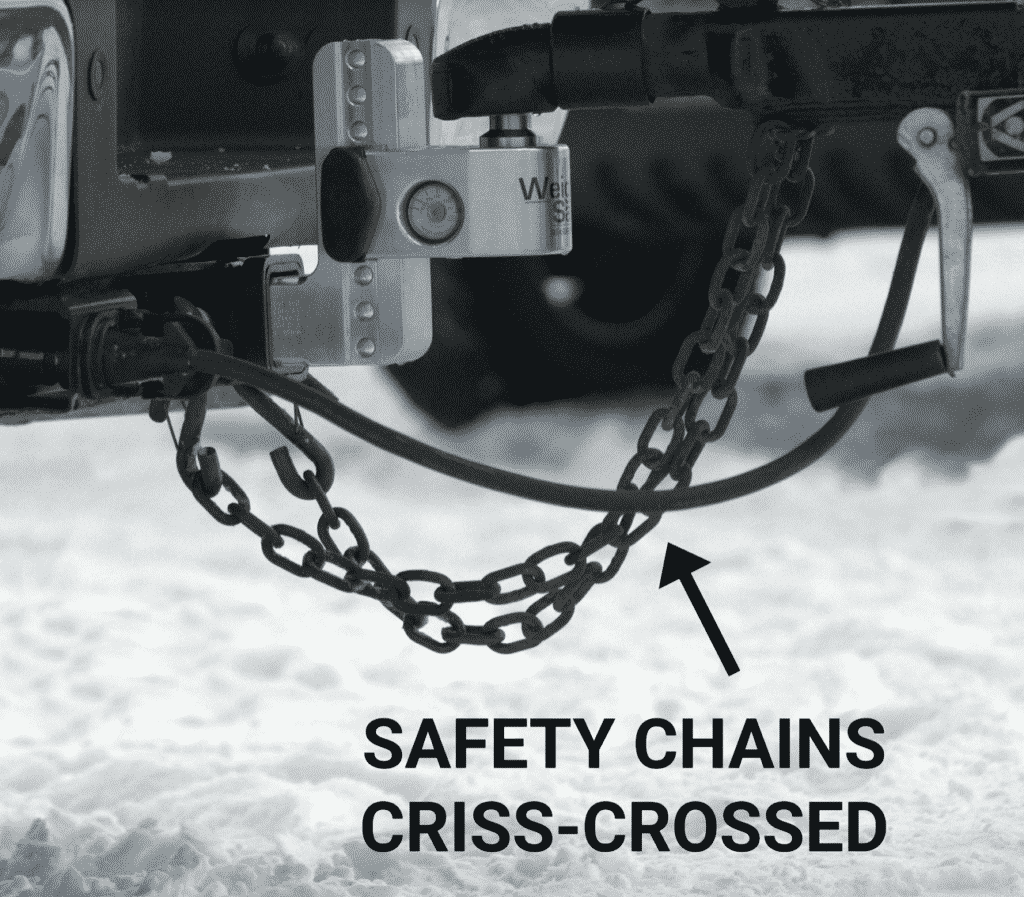
- All trailers with brakes must have an annual state inspection.
- Breakaway brakes: Like safety chains, these prevent accidents when your hitch fails. These are power brakes that apply to the trailer upon separation from your truck.
- Some states have no rule regarding brakes and others require brakes on all trailers. For trailers with more than one axle, some states require brakes on all axles, some require brakes only on a single axle.
- Tail lights, brake lights, and license plate lights
- Turn signals and 2 or more red reflectors
- Clearance lights: In the state of Utah, a trailer over 80 inches must have clearance lights.
- UCA 41-6a-1604
- Pro tip : It’s up to you, of course, to make sure all of your lights are working any time you hit the road, so always check tail, brake and signal lights before each trip.
WEIGHT AND SIZE
- In the state of Utah, you may not tow a trailer on any highway with a gross weight in excess of 10,500 lbs on one wheel UCA 72-7-404
- The maximum trailer height in the state of Utah : 14′ UCA 72-7-402(1)
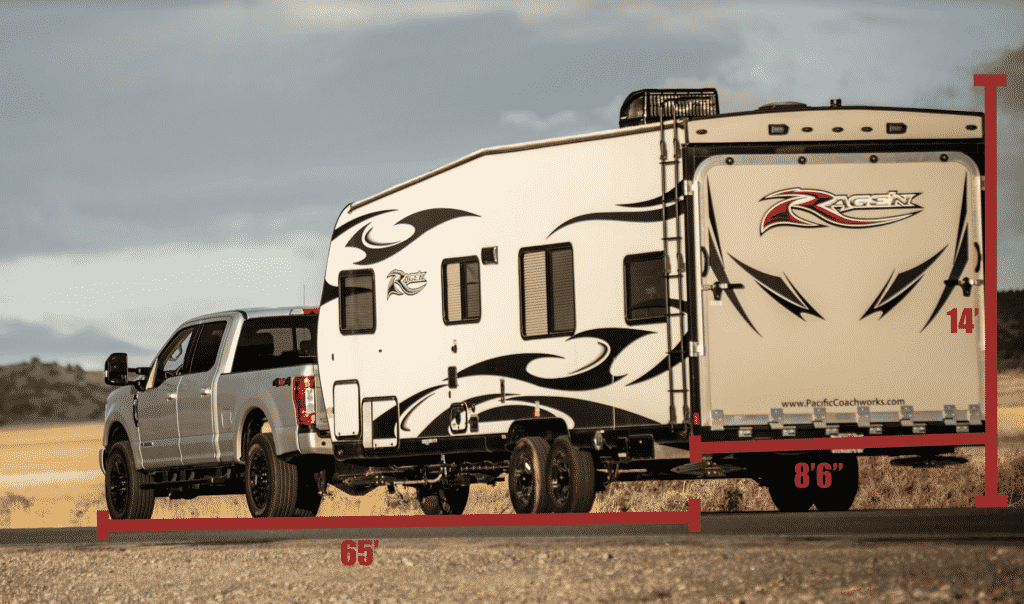
- The maximum trailer width in the state of Utah: 8′ 6 UCA 72-7-402(1)
- Pro tip : In most states, a trailer more than 8 feet 6 inches in width is considered a “wide load” and subject to a number of regulations, such as special permits, flags or banners, and limits on when the trailer can be on the road (no weekends in some states, for example).
- In the state of Utah, a truck-trailer combination is allowed up to 65 feet of overall length. UCA 72-7-402
SAFETY MEASURES
- You can avoid incidents and legal claims by becoming familiar with all parts and safety requirements of your tow set-up…
- Hitch: Learn how to operate your hitch or drawbar and secure it properly for travel.
- Pro tip : check out this video, Dangers of Improper Tongue Weight
- whips or swerves from side to side dangerously or unreasonably; or
- fails to follow substantially in the path of the towing vehicle.
- UCA 72-7-403
- For this scenario, you’d want to bring several ratchets to position and secure both pieces of equipment to your trailer
Get off to a to great start by checking out this article: Definitive Guide to Safe Towing
When do federal trailer towing regulations apply?
The simplest answer: When making money is involved.
If you are a business owner, towing a trailer for business purposes, or furthering commercial operations of any kind, then federal safety regulations apply to you.
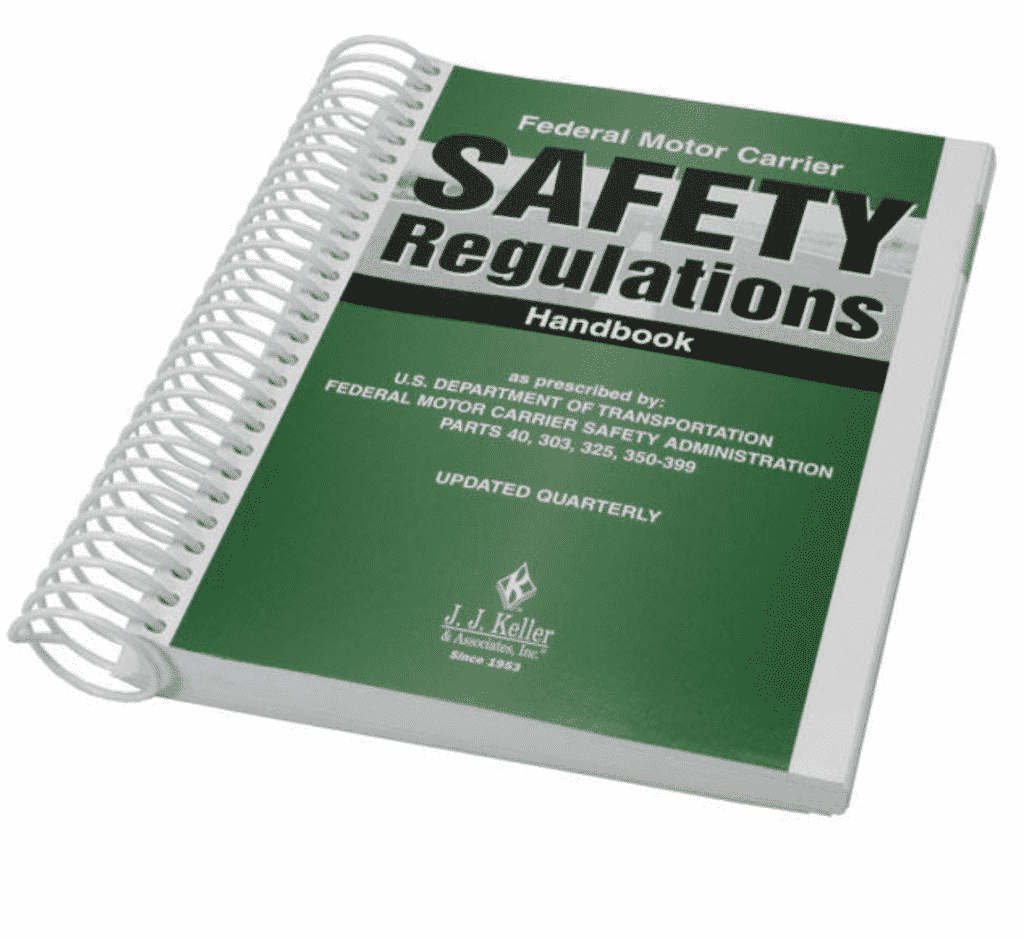
And, yes, Federal Safety Regulations even apply to individuals who choose to participate in professional competitive events such as:
- motor sports
- rodeos and horse shows
- fishing tournaments
Here’s some questions to help you evaluate if federal regulations apply to you:
- Do you declare prize money as income from a business for tax purposes?
- Are the costs for the underlying activities deducted as a business expense for tax purposes?
- Do you accept products and/or money for advertising a sponsor?
- Is your trailer being used in the furtherance of commercial operations?
If you answered “YES” to any of these questions, you are legally required to follow appropriate commercial regulations for the locations you travel, intrastate or interstate. ( Federal Motor Carrier Safety Regulation, Part 390.3 )
Requirements for towing a trailer commercially
As we mentioned above, drivers who plan to tow commercially need to be ready to take their safety regulation awareness to a whole other level.
But, let’s also be clear on this one thing:
There’s no way the full extent of federal safety regulations for commercial carriers can be fully explained here.
However, we can get you started by emphasizing that the safety of your staff and protection of your business relies on the following:
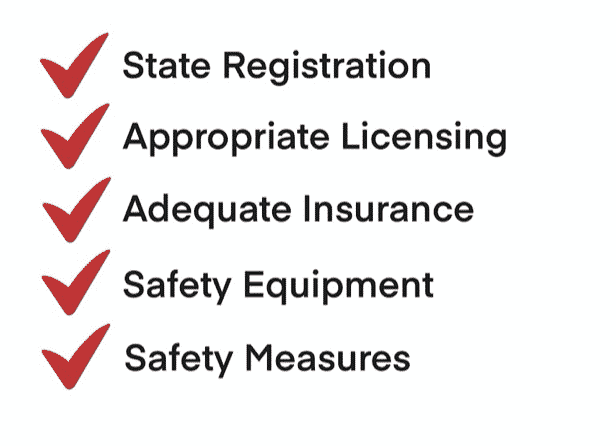
So, are you ready to kick it up a notch??
Alright then, let’s move onto the next big important factor…
Big Factor #2:
Is your gvw more than 10,000 lbs.
When it comes to towing for commercial use, you will encounter drastic changes once you cross the threshold of 10,000lbs GVW.
What kind of changes?
Well, not necessarily any changes to your tow set-up or equipment.
You’ll notice big changes in the cost of your insurance, required regulations, and associated licenses.
Let’s use another example to illustrate…
Example #2: Towing 12,000lbs of landscaping business equipment
Okay, so now, let’s say you are a landscaping business owner living in Salt Lake City, Utah. Your business has grown in size, and you’re hoping to send a couple of employees and 12,000lbs of landscape equipment to complete a job in Ogden, Utah. You ask yourself:
“Do I know the regulations required to get this job done, legally?”
“Er…..” You realize you don’t know exactly what the federal safety regulations are for towing trailers.
So, you head to google… and now, here you are, ready to follow this simple guide:
MINIMUM FEDERAL REGULATIONS TO COMPLY WITH
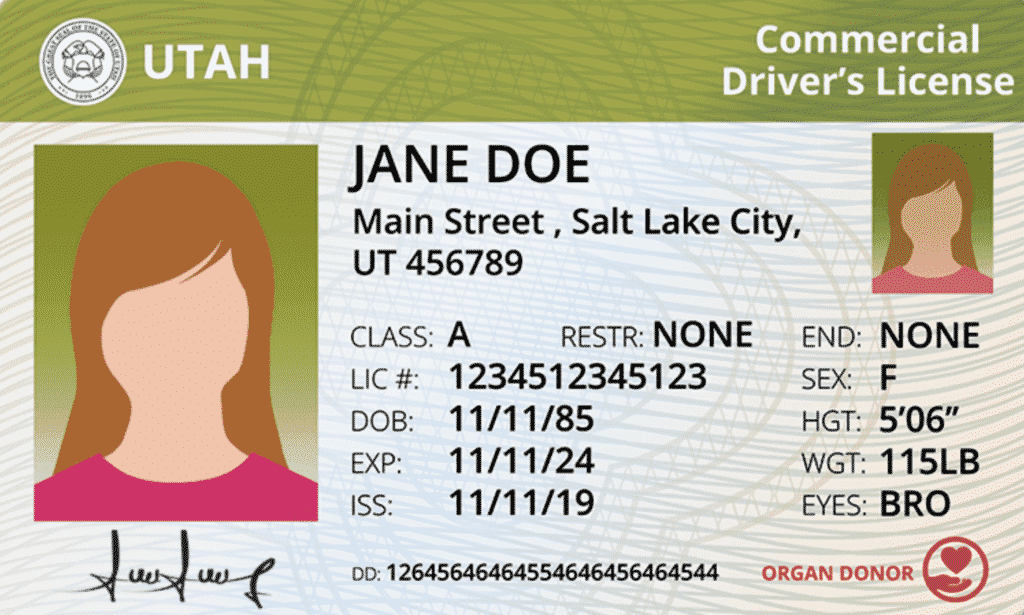
- In this scenario, your crew will be towing a trailer with a GVW (gross vehicle weight) of over 10,000 lbs. This is kind of a big deal. Why? Because…
- Any commercial driver towing a trailer exceeding 10,000 lbs GVW, needs to hold a current CDL or “Commercial Driver License”. UCA 53-3-412
- Federal Regulation Commercial Driver License Standards – 49 CFR 383
- Federal Motor Carrier Safety Regulations – 49 CFR 390
- As with towing a trailer for personal-use, you’ll want to make sure both your truck(s) and trailer(s) are registered in the state of Utah.
- CDL drivers are required to have a DOT medical card in their possession Utah Department of Public Safety, DOT card
- You must have a USDOT number and display it on your power unit in addition to the carrier name. Utah Department of Transportation, USDOT numbers
- Transport vehicle(s) must carry proof of an annual inspection Federal Motor Carrier Association, Inspections
- Drug and Alcohol Testing applies
- Record keeping applies
- Accident recording applies
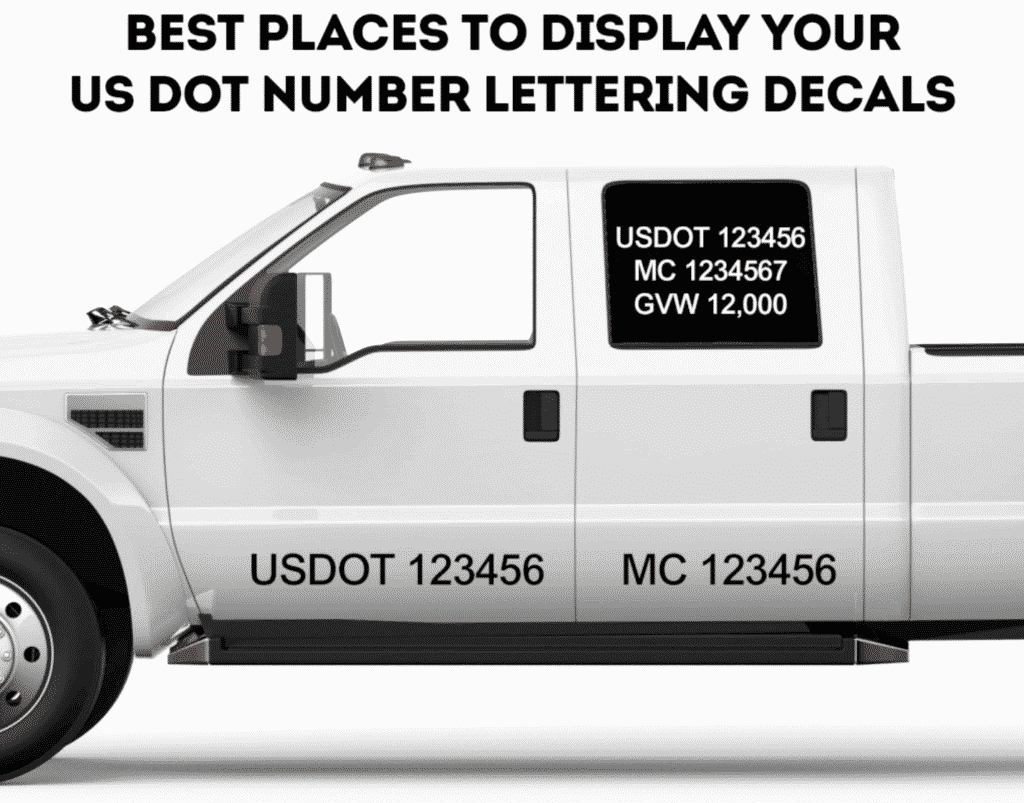
- Utah state law requires all commercial auto policies to have a minimum liability limit of $25,000 per person, $65,000 per accident for bodily injury and $15,000 for property damage. UCA 31A-22-305
- In this scenario, it would be important for you to choose limits that match your business vehicles in addition to what’s required by Utah law. Failure to do so could leave you responsible for a claim that financially affects your business. Utah Insurance Department, Business Use of Your Auto
- Other Helpful Resource: Motor Carrier Insurance Requirements
SAFETY MEASURES AND EQUIPMENT
- For towing more than 5,000 lbs: check out this article: Complete Guide to Towing with a Weight Distribution Hitch
- For towing 16,000 – 30,000 lbs, or more: check out this article: The Ultimate Guide to Safe Heavy-Duty Towing
Other helpful resource: Utah DOT & Safety Regulations
Big Factor #3:
Are you crossing state lines, you may be wondering…, “do i need to be mindful of the differences from one state’s trailer towing regulations to another”, our answer: , yes, especially, if you are towing a trailer for commercial use., intrastate vs interstate.
INTRASTATE COMMERCE – hauling loads in only one state
- Mandated by the state
INTERSTATE COMMERCE – crossing state or country borders
- Handled by the Federal Motor Carrier Safety Administration (FMCSA)
- 49 CFR 390.5
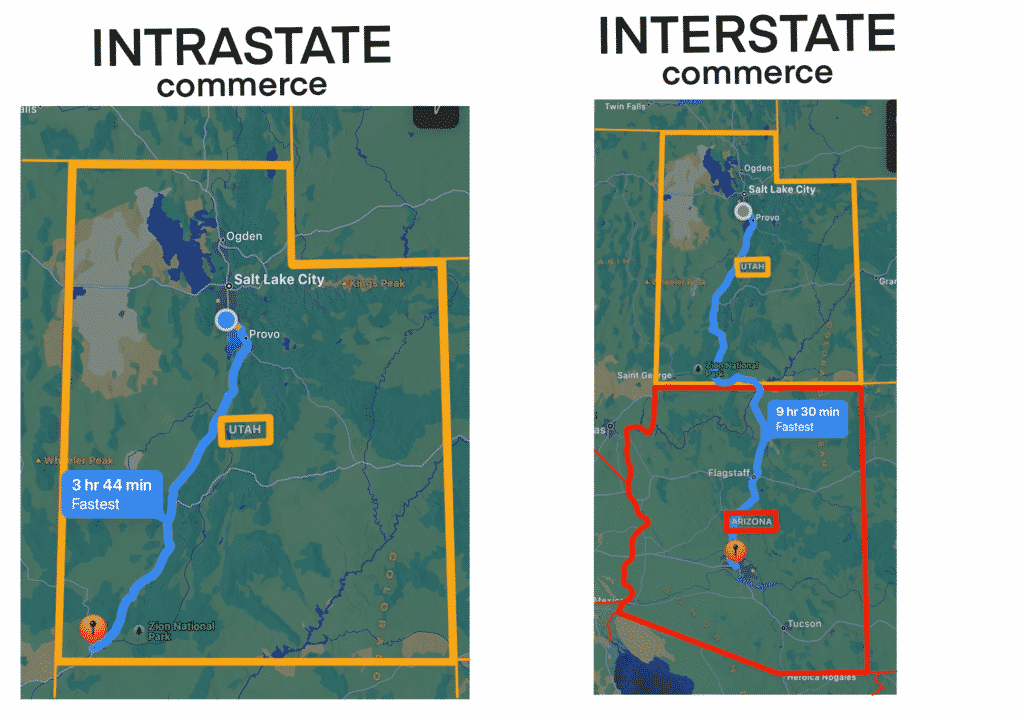
When are you subject to inspection?
In general, if you are transporting loads intrastate with a privately owned pickup or light duty truck, you will rarely be pulled over for inspection – unless a clear, visual violation is apparent:
- trailer overload
- trailer sway
- unlevel trailer and truck
However, if you get in an accident – your truck, trailer, and towing equipment will be subject to a strict DOT inspection (Department of Transportation).
For great tips on avoiding towing violations, check out this article: Seven Risks You Take by Not Measuring Your Trailer’s Tongue Weight
This brings us to our next example…
Example #3: Towing 20,000lbs of landscaping business equipment across state boundaries
Okay, so now, let’s say your business has grown big enough that you are ready to send your employees, and 20,000lbs of landscape equipment, to complete a job in Bear Lake, Idaho.
This means you have answered ‘YES’ to all three of the big factors we’ve discussed, so far….
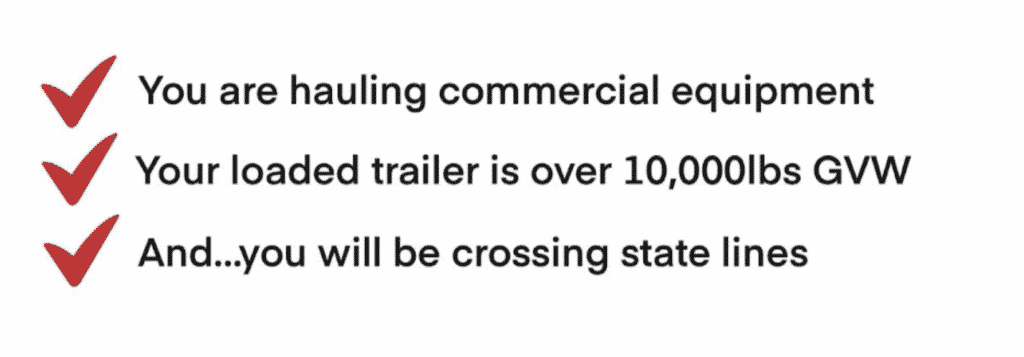
You’re feeling pretty confident about handling commercial registration, licensing, insurance, safety equipment, and taking proper safety measures.
But, now you’re curious…
“As a business owner, towing for commercial purposes, what can I expect when crossing port of entries at state borders?”
Answer: In most cases, nothing!
Passing through Port of Entries
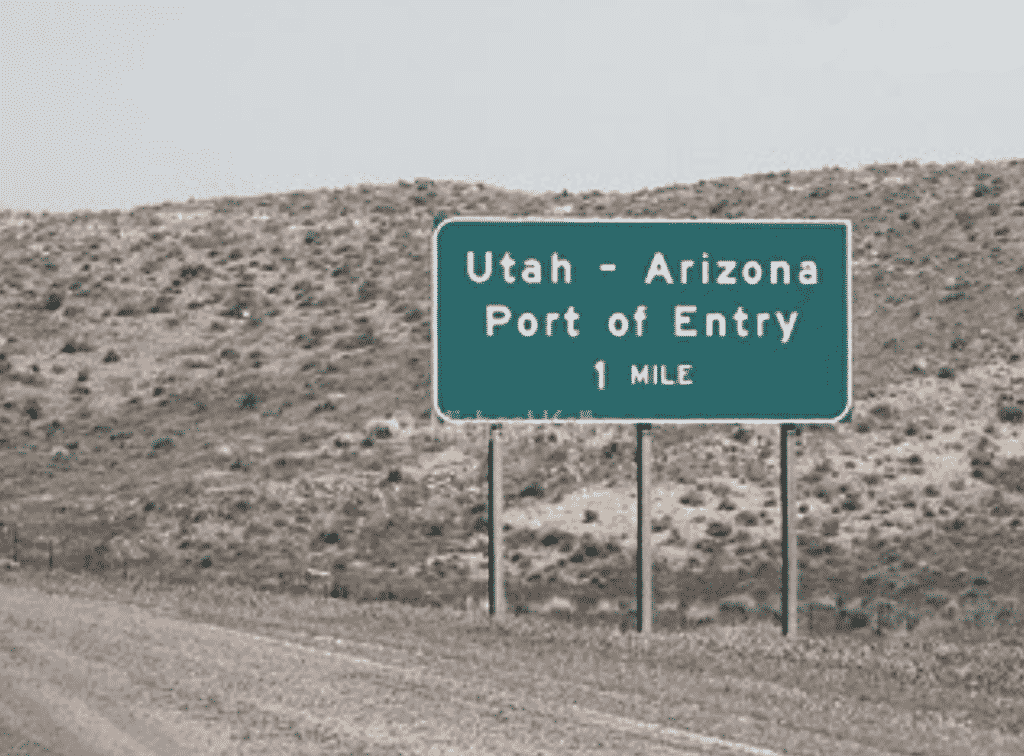
Most port of entries are fairly automated and allow the vehicle to ‘pass’ through the port at a slow rate of speed. As you pass through:
- Officers will visually inspect your load
- In-road scales will capture the weight of your vehicle
If everything is in order, you’ll simply receive a greenlight to continue forward. If something were to be noticed during inspection, i.e…
- a missing motor carrier number on the vehicle
- a load that seems to be overweight
- or, a load of hazardous materials that doesn’t comply with Federal Interstate Commerce Regulations
…the driver would then see a red light with an indicator to pull into the port for further inspection and documentation.
Will I get a ticket?
If, as a commercial vehicle, you are found to be in violation of local, state or federal laws relating to legal weight, equipment specifications or drivers license type – you will be fined.
If, in the case of an accident, you are found to be in violation of any of those items – you will not only be fined, but also exposed to civil litigation for damages.
Officers manning the port of entry at each state have the ability to write a citation with a fine for safety or weight violations (or, what is called a ‘fix it ticket’, for minor violations). In extreme cases, where safety is priority, the port of entry officer has the ability to impound the vehicle until the violations are corrected.
Managing the risks of towing a trailer
We cannot finish this article without addressing one last important fact:, driver error can lead to trouble with the law, as well. .
So, in addition to following all state and federal safety regulations, you also need to practice and follow safe driving techniques. Failing to do so could be a form of negligence that creates serious legal liability.
Keep in mind that, in many cases, your trailer will weigh more than your truck. All that extra weight behind your truck will have a huge impact on your truck’s driving ability. You’ll need to learn new driving techniques to ensure safety on the road while towing:
- Know the maximum safe speed at which your truck can safely tow your trailer . You’ll need to take into account how its behavior changes depending on its load and road conditions. Proper maintenance, including keeping tires adequately inflated, is also an important part of maintaining control.
- Allow for longer stopping distances. Be more attentive to vehicles stopping suddenly ahead of you when towing, and begin braking sooner than if you weren’t towing

- Take constant care to make wider turns at curves and corners. Remember, gooseneck hitches pivot faster because they’re attached in the middle of your truck bed (not to the bumper), so you’ll need to swing wider than you would with a receiver hitch trailer.
- Drive in the right lane on highways as much as possible. This will make it easier for you to get over to the shoulder if ever you need extra stopping room or happen to have a tire blowout.
- Don’t ride your truck’s brakes on long downhills. Shift your truck’s transmission to a lower gear to help slow your speed and take some strain off of the brakes. Applying the brakes at intervals to keep the speed in check (as opposed to constant application of the brake pedal) will help keep the brakes from overheating.
- Consider Height. Trailers can be much taller than the truck, so keep clearances in mind when pulling into gas stations or low bridge situations
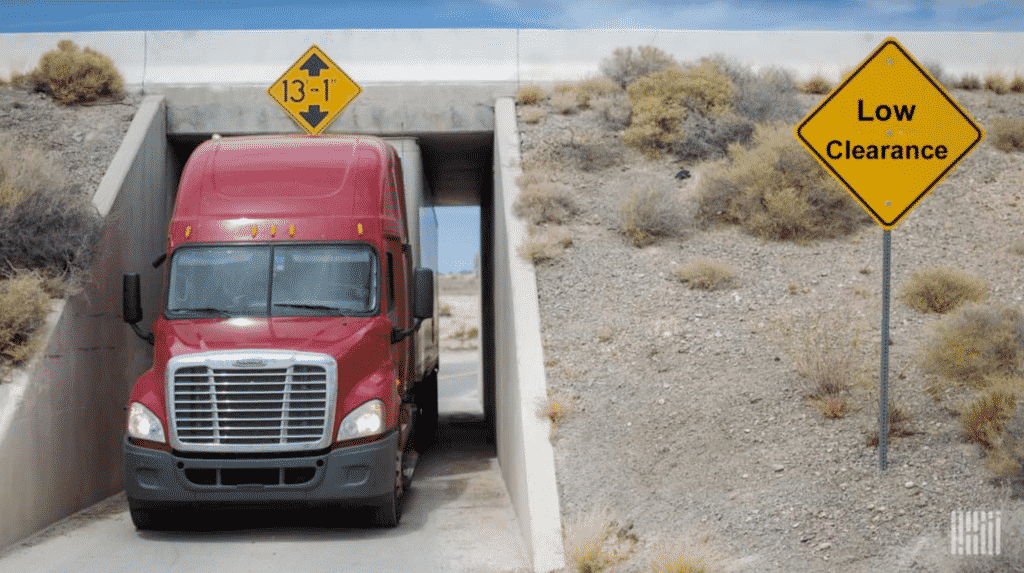
- Use a spotter when backing up. Have someone outside at the rear of the trailer while backing up whenever possible. Even wide tow mirrors can’t provide all the visibility you may need, particularly in situations where there are other vehicles, objects, or people in close proximity.
- Check your route ahead of time. Some roads don’t allow trailers on them, and certain roads also have weight, height, and width limits. Plan your route ahead of time to avoid the hassle of having to backtrack to find roads that allow your rig.
This article doesn’t even come close to covering the full extent of trailer towing laws and safety regulations (especially for commercial carriers) – however, drivers who take these three big factors into consideration will be well on their way to towing safely and legally!
For more support and tips on towing, you can browse some of our how-to videos , or feel free to contact us with any of your questions. We’re here to help!
WEIGH SAFE 180 BALL MOUNT
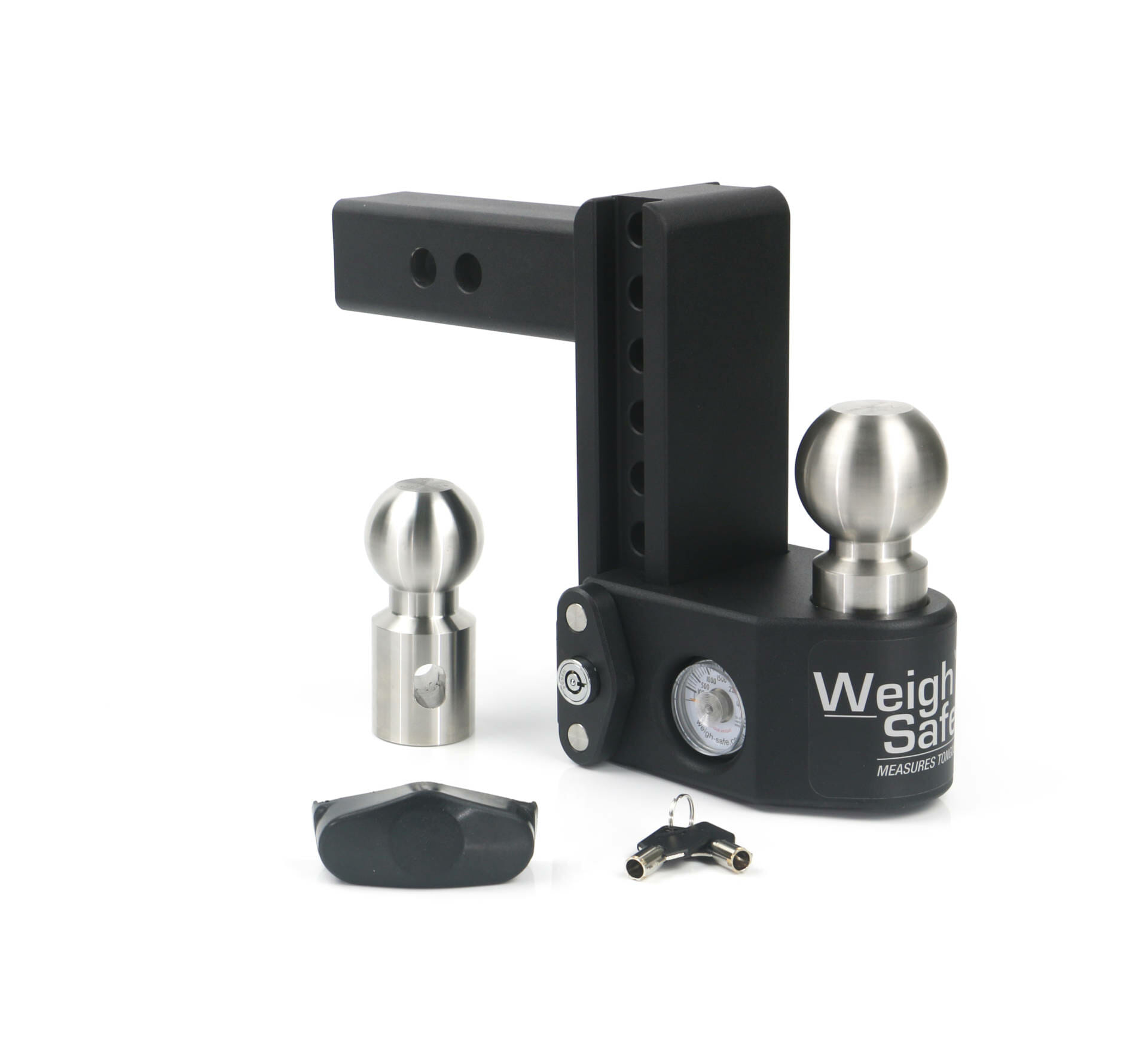
STEEL WEIGH SAFE ADJUSTABLE BALL MOUNT
Steel weigh safe 180 pro ball mount, weigh safe aero hitch, cerakote black weigh safe adjustable hitch, cerakote black weigh safe 180 ball mount, weigh safe fixed height ball mount.
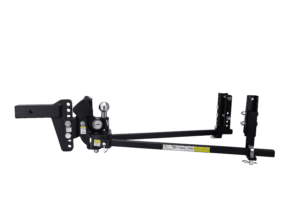
TRUE TOW HEAVYWEIGHT WEIGHT DISTRIBUTION - ORIGINAL
True tow middleweight weight distribution, weigh safe oem gooseneck, weigh safe b&w gooseneck, weigh safe in-bed rail gooseneck, weigh safe vehicle recovery hook, weigh safe soft shackle ring, weigh safe hard shackle, weigh safe cerakote recovery hook, weigh safe cerakote soft shackle, weigh safe ball coupler lock, weigh safe trailer coupler latch lock, weigh safe padlock, weigh safe 3pc lock set, weigh safe extra keys, weigh safe all locks & keys.
- WARRANTY/RETURNS
- ABOUT WEIGH SAFE
- NEW DEALER REGISTRATION
- DEALER RESOURCES
- DEALER LOCATOR
- BRAND AMBASSADORS
- SOCIAL MEDIA
Privacy Overview
Username or email address *
Password *
Remember me Log in
Lost your password?
Email address *
A link to set a new password will be sent to your email address.
First name *
Last name *
Phone *
I have read and agree to the website terms and conditions *
Your personal data will be used to support your experience throughout this website, to manage access to your account, and for other purposes described in our privacy policy .
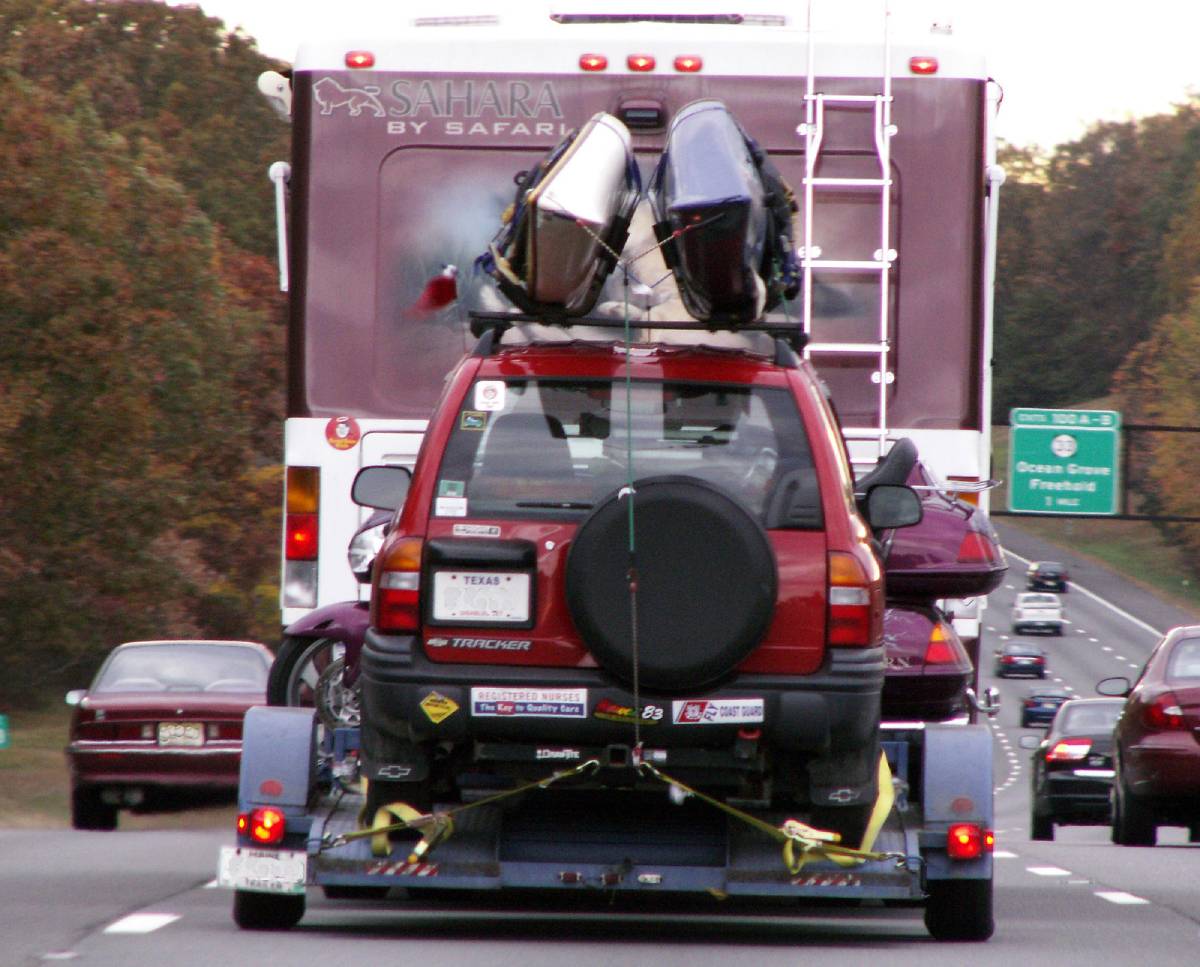
Triple Towing: What You Need To Know Before You Pull 2 Trailers Behind A Car, Truck, Or RV
5th wheel trailers , alaska , arkansas , backing up , california , colorado , idaho , illinois , kansas , louisiana , maryland , michigan , mississippi , montana , motorcycling , motorhomes , nebraska , north dakota , ohio , oklahoma , predicaments and emergencies , rv videos , south dakota , towing , travel trailers , utah.
Let’s face it, sometimes you need to be able to pull 2 trailers behind one vehicle:
- You might want to tow a toy — like a boat, motorcycle, golf cart and a vehicle behind your RV — like this .
- Or maybe you’d like to tow a camper and a boat behind your vehicle — like this .
- Maybe you have ATVs, bicycles, motorcycles, etc. inside your toy hauler and you’d like to tow it along with another trailer to your destination.
The point is… there are times when just one trailer isn’t enough for everything that you want to bring along with you!
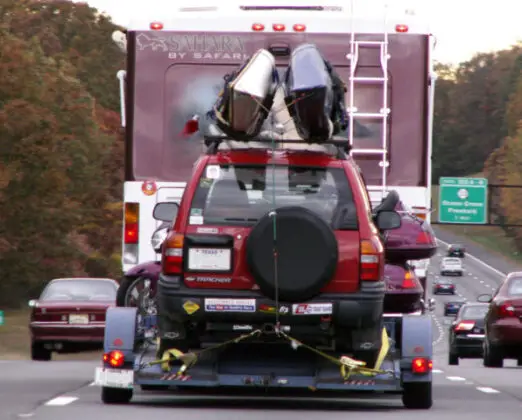
Here’s some good news: in many states it is legal to tow 2 trailers at the same time.
See which states allow triple towing , plus what you need to know before pulling 2 trailers behind 1 vehicle…
U.S. States Where Triple Towing Is Legal
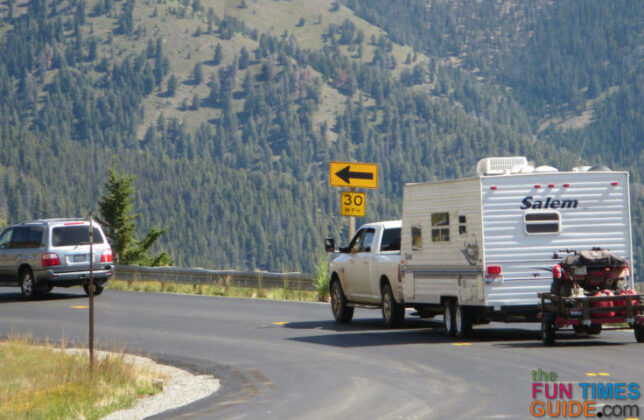
Triple towing is allowed in the following states:
- Mississippi
- North Dakota
- South Dakota
Exceptions To The RV Towing Laws By State
Of course, nothing is ever straightforward and simple though.
Many of the above states still have a variety of restrictions which could hamper your ability to tow 2 trailers:
- Some states limit the total length of all 3 units to 65 feet — in other states, the limit is 70 feet or 75 feet total length.
- In some states, triple towing is restricted to adding the second trailer only behind a 5th wheel trailer .
- Many states limit the second trailer to recreational equipment — such as a boat, snowmobile, or ATV 4-wheeler.
- In some states (like California and Michigan) you need a special endorsement on your drivers license to tow any trailer over 10,000 lbs or to drive a motorhome that is over 40 feet in length.
Towing Rules For Commercial Trucks vs. Recreational Vehicles
As far as state DMVs go, the world of recreational vehicles and the world of commercial trucking are two separate entities.
Some states allow “double towing,” “triple towing,” or however you wish to label a situation where you have 2 trailers hooked behind one tow vehicle in the commercial truck classifications. But, these rules may not cross over to the RV world !
Commercial triples are set up such that the air brake system continues on through all 3 pieces. And the second trailer rides on a fifth wheel tow dolly — not a 2-inch chrome ball purchased at the local hardware store. Therefore, when commercial trucks apply the brakes, all wheels will apply at the same time with equal pressure.
On the other hand, recreational vehicles may have:
- Air brakes on the motorhome
- Electric brakes on the first trailer
- And, in many cases, no brakes at all on the third item being towed
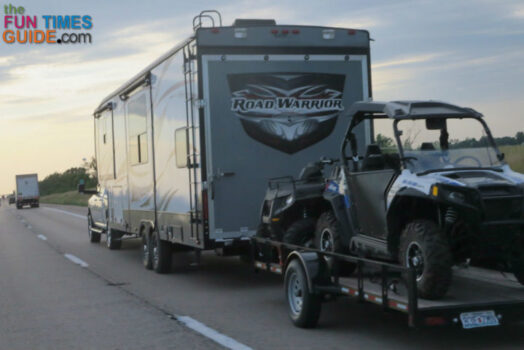
To that end, the federal D.O.T. doesn’t want any part of regulating non-commercial situations — so, they leave it completely up to each state to set their own limitations for RV towing .
Just remember, seeing a semi truck pulling 2 trailers on or near an interstate highway does NOT mean you’re good to go with more than one trailer behind your motorhome!
Double / Triple Towing Laws By State & By Vehicle
There are 4 great sites that list trailer towing rules and regulations — by state and by vehicle:
- Good Sam’s Rules of the Road (formerly Woodall’s Rules of the Road) – This site appears to have the most information about triple towing regulations by state . In fact, it provides more information beyond simply whether triples are allowed or not. As an example… here in Minnesota, triples are allowed, but the second trailer must be recreational equipment such as a boat, snowmobile, or ATV 4-wheeler.
- Ready Brake – This site provides a good chart that shows tow brake laws by state .
- Flat Towing Guide – This site summarizes factory tow ratings for every vehicle , which is helpful if you’re thinking of towing four wheels down.
- RV Safety & Education Foundation – This site provides weight ratings for pickup trucks including GVWR (gross vehicle weight rating), GCWR (gross combined weight rating), and Maximum Trailer Weight ratings by vehicle.
The difference between GVWR and GCWR .
Of course, these resources should only be considered basic guidelines — because laws change and information can get mixed up in translation.
The only way to get completely accurate information about triple towing is to contact the Department of Transportation or Highway Patrol offices for your state and any states you plan to travel through .
If you do tow 2 trailers, be sure to follow all regulations and safety measures — because you will be accepting a whole new level of responsibility with that second trailer. Your ability to maneuver in close spaces (or to stop safely) may be reduced considerably. One thing’s for sure, you can forget about backing up when you’re triple towing — getting everything to turn the way you want in a triple-tow configuration will be next to impossible!
READ NEXT: How To Drive An RV When You’re Towing A Trailer
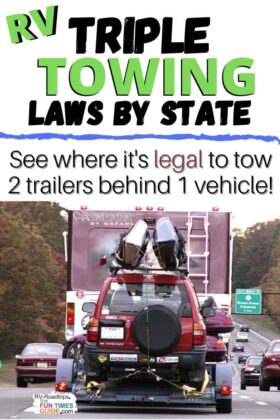
I’ve been involved in RVing for over 50 years — including camping, building, repairing, and even selling RVs and motorhomes. I’ve owned, used, and repaired almost every class and style of RV ever made. I do all of my own repair work. My other interests include cooking, living with an aging dog, and dealing with diabetic issues. If you can combine a grease monkey with a computer geek, throw in a touch of information nut and organization freak, combined with a little bit of storyteller… you’ve got a good idea of who I am. To date, I’ve shared my RV knowledge in over 300 articles here at The Fun Times Guide! Many of them have over 25K shares.
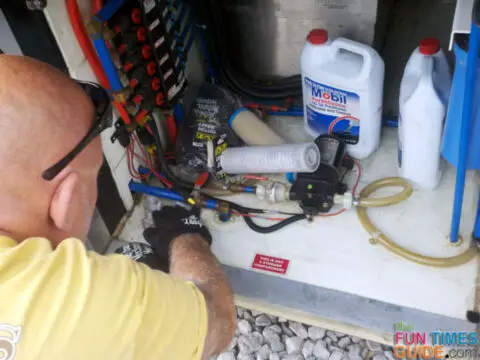
Featured articles
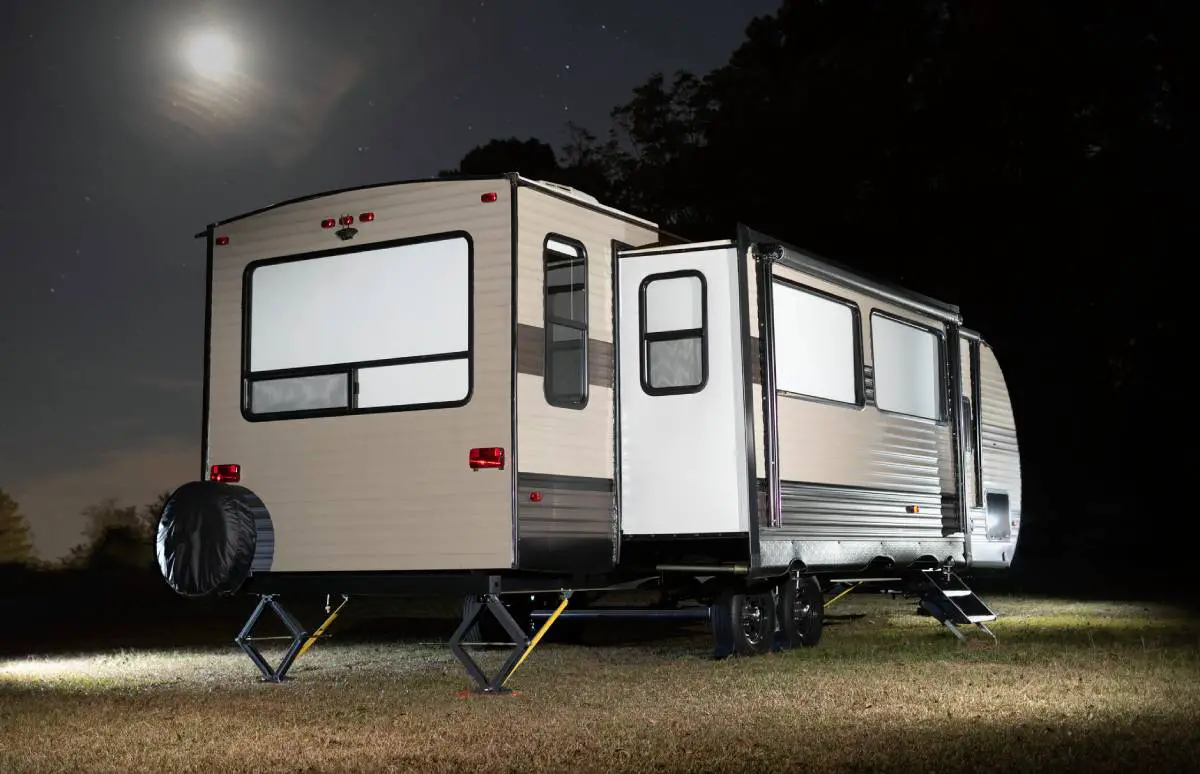
Help! My RV Slide-Out Is Stuck… How Do I Adjust The Slide-Out Manually?

DIY RV Dinette Replacement: Make Better Use Of Your RV Living Space By Removing The RV Dinette Table
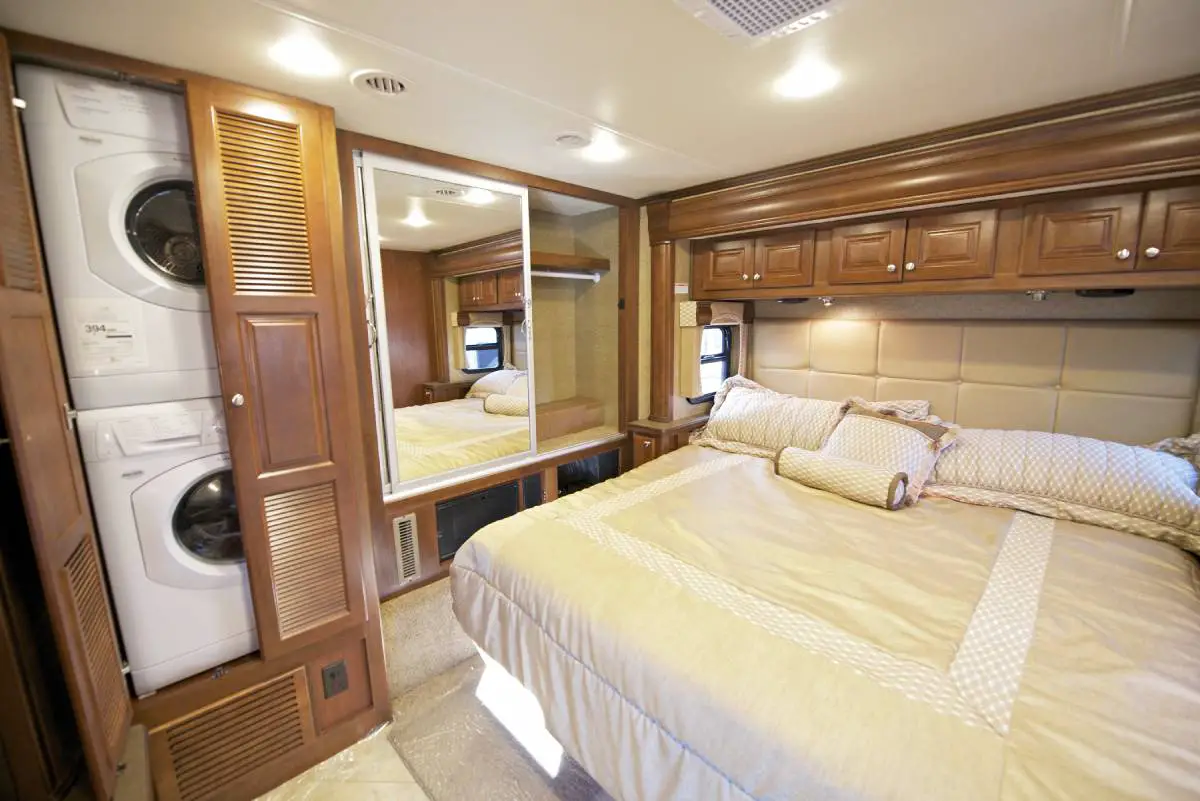
Need A Replacement RV Mattress? RV Mattress Sizes & Shopping Tips

- 800.265.9019
- 595 NJ 33, Millstone Twp, NJ 08535
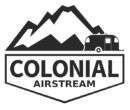
TOWING GUIDES
Vehicle towing capacities for travel trailers.
At Colonial Airstream, our goal is to help you find the perfect travel trailer for your needs and lifestyle. We sell a large volume of Airstream travel trailers which encompass many different weights and lengths. The year and towing capacity of your vehicle will determine which trailer is best suited for you and your family. Please use the following towing guides to educate yourself on RV towing, and to verify your vehicle’s towing capacity.
Click on any picture below to download a PDF of that year’s tow guide.
2020 Towing Guide
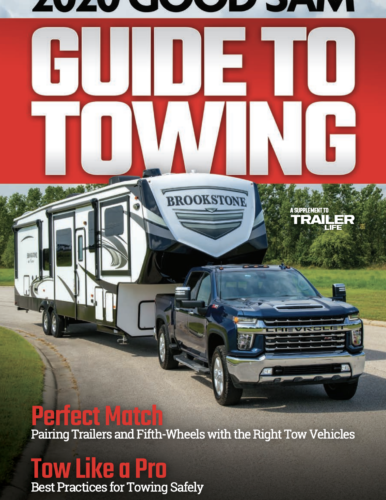
2019 Towing Guide
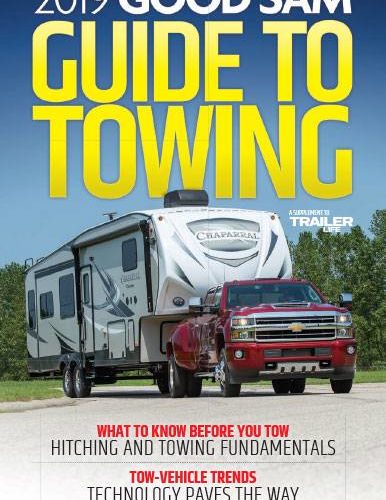
2018 Towing Guide
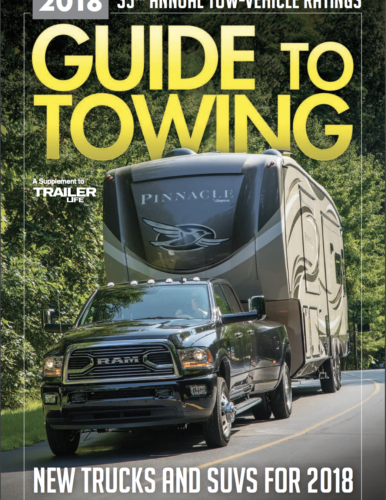
2017 Towing Guide
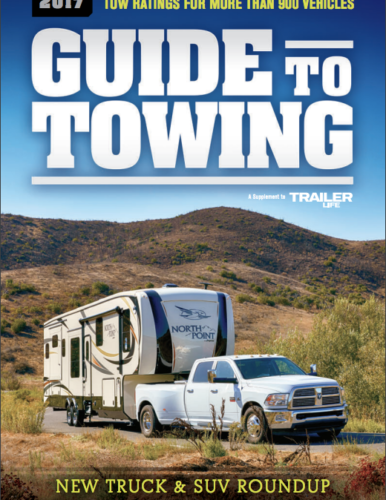
2016 Towing Guide
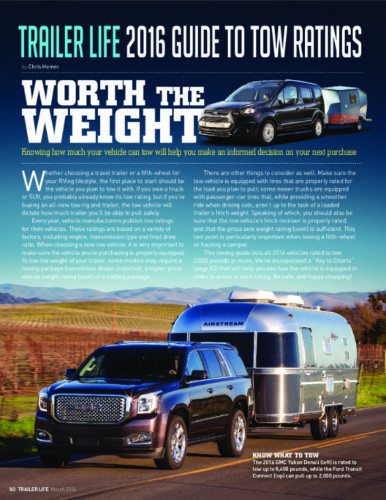
2015 Towing Guide
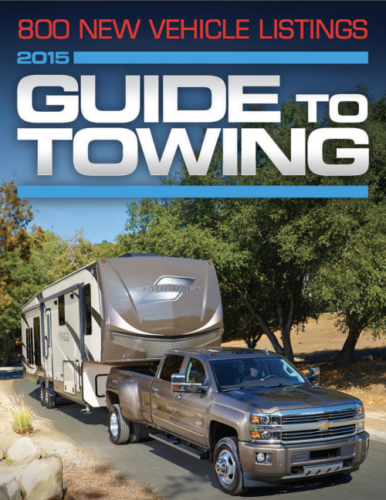
2014 Towing Guide
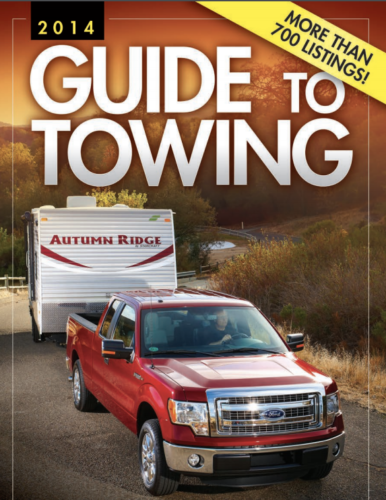
2013 Towing Guide
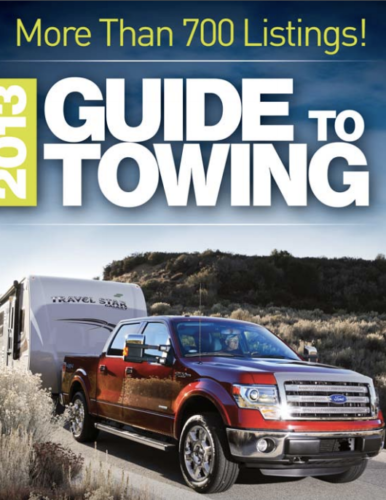
2012 Towing Guide
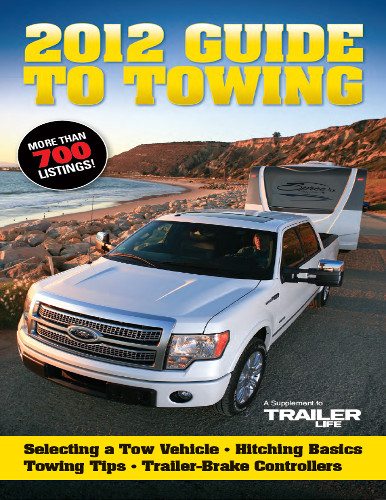
2011 Towing Guide
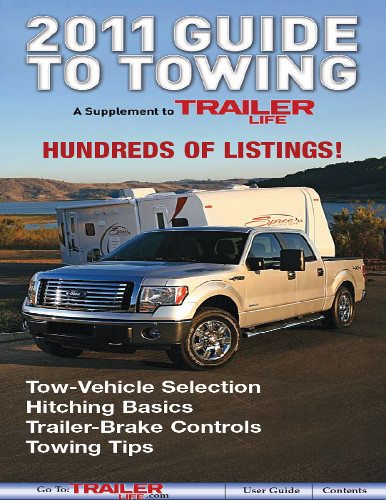
2010 Towing Guide
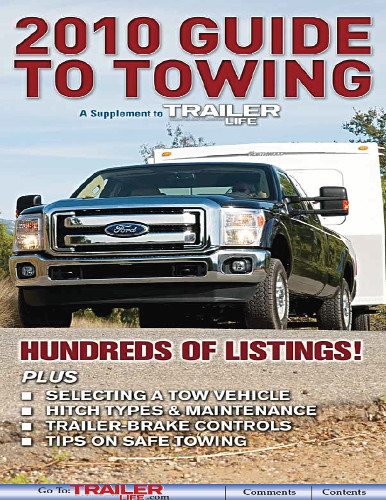
2009 Towing Guide
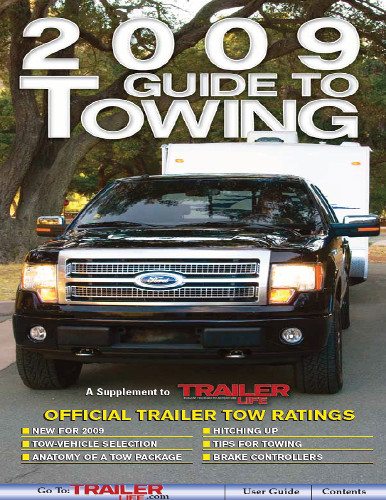
2008 Towing Guide
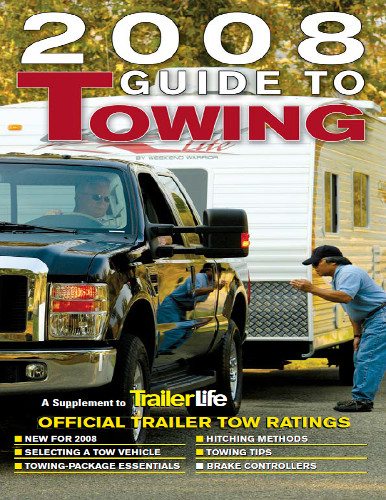
2007 Towing Guide
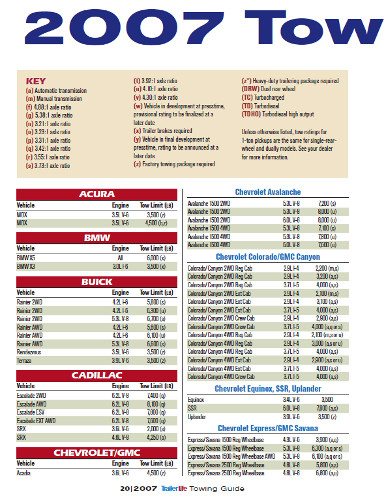
2006 Towing Guide
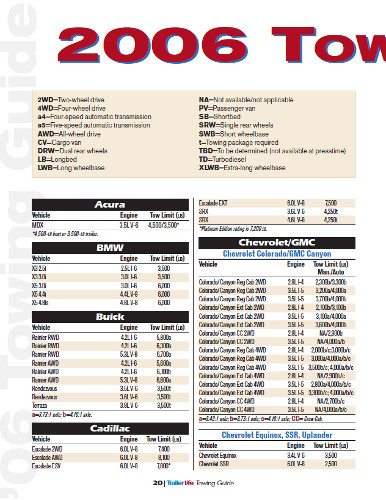
2005 Towing Guide
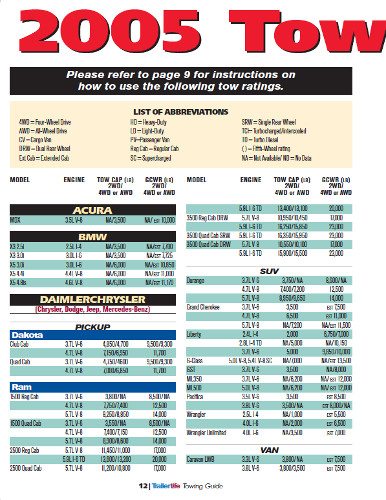
2004 Towing Guide
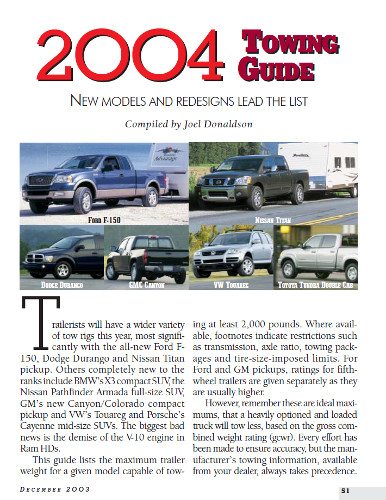
2003 Towing Guide
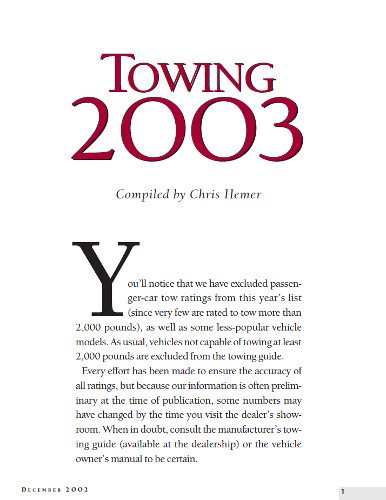
2002 Towing Guide
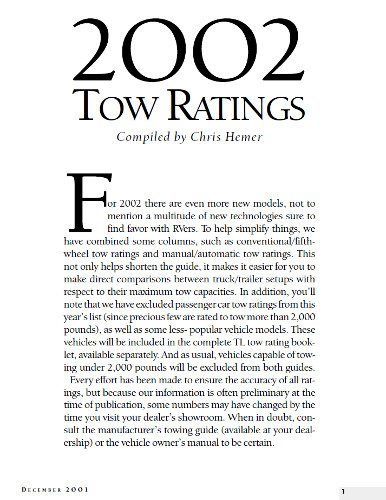
2001 Towing Guide
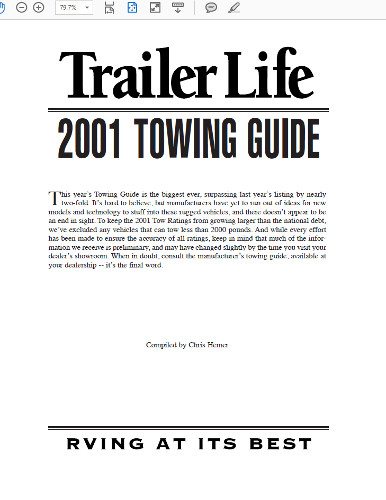
2000 Towing Guide
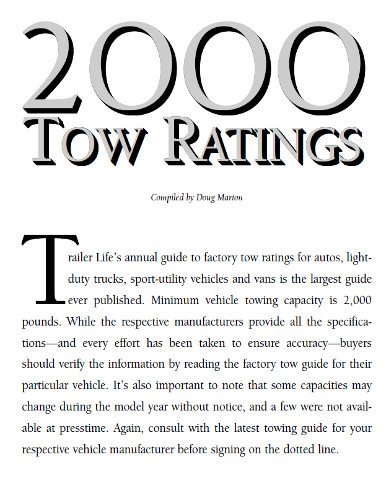
Find the perfect Travel Trailer!
Speed Limits and Towing
Speed limits.
Perhaps the most visible and economically significant form of traffic regulation, most people think they have a grasp of what the sign means. While not generally addressing towing, one of the best resources for speed limit law has for decades been the page maintained by John Carr at MIT , who more recently contributes as a writer for the National Motorists Association. It isn’t always the most up-to-date, but for generally applicable limits, it’s the place to go. He also includes discussion of tolerances, absolute vs. prima facie limits, and speeds at which various state laws carry significant penalty or additional reckless driving charges.
But he doesn’t include truck or RV speed limits. Fortunately, the number of states still clinging to split speed limits continues to fall. Every state has a basic speed law that requires you to drive at a safe speed–which for an RV often means less than the limit, especially in the many states with 75 and 80 mph limits in effect. The limits of the road, weather, traffic, your vehicle, and your skills as a driver all enter into the determination of what speed is safe, and it’s hardly constant. When the Ohio Turnpike commission experimented with eliminating the 55 mph restriction on vehicles over 8,000 lbs, the results were sufficiently compelling that the legislature eliminated them on the interstate system statewide.
For the most part, there are now only 5 states where an RVer is subject to a general speed restriction different from the rest of traffic: California (55), Idaho (70), Indiana (65), Montana ( 70 ), and Washington (60). Of those, California is the worst offender, requiring you to drive 15 mph slower than the generally applicable speed limit for cars. But remember: your duty is first to drive at a speed that is reasonable and prudent under the conditions existing while you’re behind the wheel. Even if the law doesn’t specifically prohibit driving 85 mph for your vehicle, the basic speed law may require you to drive at a different speed. The same is true for slow speeds as well.
The charts below summarize the basics, but continue reading for more detail. The table at the end of the page includes a 50-state list, with links to state statutes. Remember that just because your vehicle is defined or registered as an RV in one state doesn’t mean that you’re not a truck in another state’s speed laws.
Of course, they don’t apply to the same vehicles. Since there are only 5 of them, we’ll go through the regulations one-by-one.
Section 22406 of the California Vehicle Code establishes a 55 mph limit for certain types of vehicles, as defined in Division 1.
Any motorhome not towing: 70.
A motorhome as we normally think of one is called a housecar in California, and even if it has 3 axles, is a passenger vehicle not a motortruck or truck tractor. So a motorhome not towing doesn’t fall under either 22406(a) or (b). When it’s towing, it’s clearly a passenger vehicle drawing another vehicle, and subject to the 55 mph limit as a result of 22406(b).
With any trailer in tow: 55
Whether pickup and fifth-wheel or travel trailer, or motorhome and toad or other trailer, 22406 applies.
Idaho has a strange way of wording their restriction. They have a special restriction for vehicles with 5 or more axles and operating at a gross weight of more than 26,000 lbs that requires the speed limit to not exceed a limit 10 mph lower than the limit for vehicles with fewer than 5 axles and weighing less than 26,000 lbs. Practically, this means that the highest speed limit for restricted vehicles is 70 mph, but should Idaho modify the maximum speed limit, the large vehicle limit follows by default. However, they don’t include vehicle combinations in that definition, so it may not apply to typical RV combinations.
To be on the safe side, let’s assume it does apply to combinations, however ambiguous that might be:
- Motorhome and toad/trailer/semitrailer weighing less than 26,000 lbs: 80
- Motorhome with 2 axles and toad/trailer/semitrailer with 1 or 2 axles exceeding 26,000 lbs total weight: 80
- Motorhome with 3 axles and single-axle trailer exceeding 26,000 lbs total weight: 80
- Motorhome with 2 axles towing a 3-or-more axle trailer, exceeding 26.000 lbs total weight: 70
- Motorhome with 3 axles towing a 2-or-more axle trailer, exceeding 26,000 lbs total weight: 70
- Two-axle truck pulling 2-axle trailer, any weight: 80
- Two-axle truck pulling 3-axle (or more) trailer, exceeding 26,000 lbs total weight: 70
Those limits are based on the normal 80 mph limit, and the requirement that vehicles listed above have a speed limit no higher than 10 mph below the general limit posted, and no higher than 65 in urban areas.
After Idaho, Indiana is comparatively easy. In IC 9-21-5-2 , a maximum of 65 mph is established for any motor vehicle having a declared gross weight over 26,000 lbs. Simple enough, except that declared gross weight has its own definition.
In that definition, you won’t find any category that includes a motorhome. You will find a definition for a truck, which must include the weight of a truck camper, but not a vehicle towed by the truck. It would appear that if you have a declared gross weight of more than 26,000 lbs (again, that would be weights on a truck and/or trailer, not a motorhome or towed car), you would potentially be subject to the reduced speed limit.
- Motorhomes generally: 70
- Trucks over 26,000 lbs declared gross weight: 65
Given typical enforcement tolerances, and that it’s only a 5 mph difference, this is a largely irrelevant reduction unlike the previous states discussed.
If you’re driving a motorhome into Montana, the standard 80 mph speed limit applies. Its 65 70 mph speed limit for trucks with a manufacturer’s rated capacity of more than 1 ton does not include motorhomes, which are a vehicle type defined separately.
If you have a truck with more than 1 ton manufacturer’s rated capacity, towing or not, you’ll have to slow down to a maximum speed of 65 70 mph when you enter the state, whether from one of the Dakotas, Wyoming, or Idaho. North Dakota looks poised to follow the lead of its southern and western neighbors in increasing its maximum speed limit to 80, after which there will be either 3 or 4 states where you’ll be required to drive a speed 10 mph slower than what you were allowed to drive on your way to Big Sky country. Ouch.
As a slight consolation prize, Montana does have the ability to post speed limits greater than the statutory limits, so if you see the 80 mph sign without any additional placard, that’s what applies.
UPDATE (5/20/19): Montana has increased its truck speed limits. You’ll now be able to legally drive at 70 mph, instead of 65 mph.
Let’s suppose you’ve traveled west to get to Washington. You entered South Dakota on I-90, and continued west briefly passing through Wyoming, across Montana and Idaho. If you’ve been driving a 2-axle motorhome, towing a car, almost all of that has been under an 80-mph speed limit. Now here comes Washington, begging you to slow down by an absurd 20 mph, while only slowing the rest of traffic down by 5 mph (the legislatively set maximum is 75, though all of Washington’s Interstate highways currently have signs indicating 70 or lower). Yes, like Montana and California that can set up a 15-mph differential between your legal speed and the rest of traffic.
Even worse, while most of the other states make some effort to post what vehicles are subject to reduced limits, Washington posts signs for “trucks”, and includes this language in WA Rev Code § 46.61.410 (2017):
The word “trucks” used by the department on signs giving notice of maximum speed limits means vehicles over ten thousand pounds gross weight and all vehicles in combination except auto stages. WA Rev. Code § 46.61.410
So even though you were likely able to ignore the signs that said “Trucks 70”, here in Washington, they essentially apply to every RV. If you weigh more than 10,000 lbs or are towing, 60 mph it is.
2019-12-10: Added clarification and link referencing difference between 75 mph maximum and 70 mph speed zones in Washington.

Service Locator
- Angler Endorsement
- Boat Towing Coverage
- Mechanical Breakdown
- Insurance Requirements in Mexico
- Agreed Hull Value
- Actual Cash Value
- Liability Only
- Insurance Payment Options
- Claims Information
- Towing Service Agreement
- Membership Plans
- Boat Show Tickets
- BoatUS Boats For Sale
- Membership Payment Options
- Consumer Affairs
- Boat Documentation Requirements
- Installation Instructions
- Shipping & Handling Information
- Contact Boat Lettering
- End User Agreement
- Frequently Asked Questions
- Vessel Documentation
- BoatUS Foundation
- Government Affairs
- Powercruisers
- Buying & Selling Advice
- Maintenance
- Tow Vehicles
- Make & Create
- Makeovers & Refitting
- Accessories
- Electronics
- Skills, Tips, Tools
- Spring Preparation
- Winterization
- Boaters’ Rights
- Environment & Clean Water
- Boat Safety
- Navigational Hazards
- Personal Safety
- Batteries & Onboard Power
- Motors, Engines, Propulsion
- Best Day on the Water
- Books & Movies
- Communication & Etiquette
- Contests & Sweepstakes
- Colleges & Tech Schools
- Food, Drink, Entertainment
- New To Boating
- Travel & Destinations
- Watersports
- Anchors & Anchoring
- Boat Handling
9 Interstate Trailering Tips
Advertisement
Some factors to keep in mind when trailering a boat on the interstate highways.
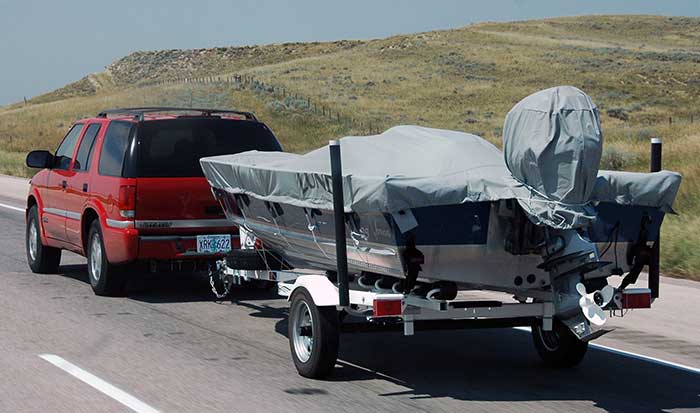
A prime benefit of owning a trailerable boat is its portability; anywhere your tow vehicle can go, so can your boat and trailer. Many trailerboaters take advantage of their rigs' "free range" capability a few times each year, towing their boats beyond the local launch ramp and onto the open road to distant waters and to enjoy on-water fun with friends or family. If you have not done much long-distance towing, there are some factors to keep in mind when trailering on the interstate highways that may not come into play during your usual runs to the home ramp and back
1. The Air Back There
The biggest difference between towing a boat on local roads and hitting the open highway for any distance is the speed and distance at which the rig will be traveling. Quite literally, that pace affects where your rubber meets the road. The higher speeds create higher heat for your trailer's tires and bearings to handle. A pre-trip inspection and replacement of suspect tires and bearings is important before any long-distance haul — as are regular checkups en route, and having replacements available in the form of spare tires, wheels, and bearings. One of the most important things you can do before a long-distance haul is to check the air pressure in your trailer and tow vehicle's tires. Do this when they are cold, and bring the pressure within the recommended guidelines listed in the trailer and the vehicle service manuals.
2. Hand On Hub
Once on the road, experienced trailer towers pull over to stretch their legs every couple of hours while performing a walk-around inspection of their rig, inspecting safety chains, looking for loose straps, and checking for overheating by placing their hands on the tires and hubs. Any surface too hot to hold a palm against may be overheating and deserve further attention.
Invasive Species: Careful ...
Don't Drag An Invader Home It's our job as boaters to prevent the spread of nuisance water plants and other species such as zebra mussels from an infested lake or river to a clean one. Fortunately, it is easy to take a few moments and add a few simple steps to your boat cleaning routine that will greatly reduce the chances of spreading invasive species. The mantra is "Clean. Drain. Dry."
CLEAN : At the top of the boat ramp after loading your boat, inspect your rig for any plants or mud clinging to the boat, motor, bunks, or trailer. Remove any plant life or mud right then and there.
DRAIN : You probably popped the drain plug out at the top of the ramp, but if not, do so now. If you have a live well, empty it. Same goes for anchor lockers or any other compartment that might hold water. As you clean your boat, leave hatches open.
DRY : Two things are deadly to invaders such as zebra mussels: heat, and desiccation (drying out). If you have access to hot water (140+ degrees F) where you wash your boat, great. If not, you’ll want to make sure your boat and all your gear such as tow ropes, skis, tubes, and wakeboards have a good long time to completely dry. Five days is recommended if you boat on a body of water with a known invasive species problem. An alternative is to dip your gear into either a 100-percent vinegar bath for 20 minutes, or a five-percent detergent bath for 40 minutes (2 cups of dishwater detergent to 2.5 gallons of water).
To read more about the race against invasives, see, " The Arms Race Against Invasives ".
3. Got You Covered?
Highway speeds can also compromise boat covers and canopies that may stand up to briefer, lower-speed runs to area launch ramps but fail when buffeted about over a long haul. It is really important that you make sure any cover you leave on a towed boat is designed for over-the-road use and the abuse it will be expected to withstand. Boat covers intended for use at highway speeds have a series of heavy-duty straps that wrap around the craft to snug the top tightly in place, using adjustable buckles. Regular walk-around inspections during the drive should include checking and tightening all cover straps, which can loosen with exposure to wind and water.
4. Support Your Bimini? — Take It Down
Bimini tops should be collapsed and their covers folded and encased in the boot, secured to the lowest point possible, either against the top of the windshield or along the gunwale. The support braces that hold Biminis semi-erect while folded in the boot are designed for use at boating speeds not highway speeds. Even properly covered and secured, Bimini tops, their hold-down straps, and their attachment points on the boat should be inspected regularly during any over-the-road trip.
5. Equipment
Electric trolling and auxiliary motors should be removed and securely stowed whenever possible before an extended towing trip. Aftermarket supports and locks are available for both if they are to remain attached to the deck or transom. Likewise, electronics such as fishfinders, VHF radios, and GPS receivers should be mounted on quick-release bases that allow the units to be easily removed for over-the-road towing and general security. Anchors should be removed from the bow and secured in chocks made for this purpose; you can imagine the damage even a 15-pound anchor can wreak when left loose to bang around on a deck or inside a compartment.
6. Don't Lose It
On the other hand, lighter accessories such as personal flotation devices, seat cushions, coolers and lids, and even deck carpeting that may work loose must be secured or stashed where they will not be vulnerable to blowing out of a boat that may be going twice as fast — and for much longer duration — than when the craft is on the water.
Shadow Boxing
A trick I use when trailering a boat on the highway during daylight hours is to take advantage of my rig's shadow whenever possible.
When sunlight creates a shadow of my boat and trailer on the road surface while underway, I use it and the shadow of vehicles that I have passed to give me an additional visual clue about our proximity to each other. Only after I have seen my rig's shadow pass that of the other vehicle's do I begin my merge back into the travel lane.
I have also been alerted to a loose Bimini that had come un-snapped from its stowed position and would have been lost had I not seen the Sunbrella's flapping shadow.
7. It's Not Always A Breeze
Winds can also affect the handling of trailered boats and tow vehicles. You'll notice many tractor-trailer rigs pulled over and parked at rest and truck stops along the highway during periods of high wind as the operators wait out the weather that threatens their high-profile rigs. Natural breezes and the draft created by large vehicles when passing can temporarily cause the trailer to sway, unnerving unsuspecting drivers.
Large-volume vehicles such as tractor-trailers and motor homes develop a high-pressure wave of air in front of them and low-pressure area to their rear as they move down the highway. The effect varies depending on the shape of the truck and conditions, but when a truck approaches to pass you on the left, your trailer and then your tow vehicle will be pushed to your right by the truck?s ?bow wave.? As the truck passes, the low-pressure zone it creates will then pull your rig back to the left. To compensate for the pressure variables, you need to be prepared to steer slightly left and then right to counter the effect — or at least brace yourself for a temporary buffet.
8. Overnight
Interstate travel with your trailer may also include a few things to consider when the trailer isn't moving at all. If you intend to get a hotel room, you should consider where you can safely park the tow vehicle and trailer. Because so many boat trailers are parked overnight in motel/hotel parking lots in Florida, a number of venues have set aside spaces that can accommodate the required extra length (a few Radisson Hotels do this; do your research before making the trip).
Some Trailering Club members tell me they let the desk clerk know about the rig parked outside and ask if (1) someone can periodically check on it during the night, and (2) there's a bright light in front of the building where the trailer and tow vehicle can be parked. This may also entail disconnecting the trailer if you want to drive to dinner nearby, which brings in a few other preventive measures to consider. Try to park the trailer with the tongue facing away from the parking lot so that a thief can?t just pull up, hook the trailer, and be on their way. Invest in a wheel lock or a hitch lock so any thief can't move the trailer from its parking space. One Trailering Club member says he's devised a lock using a golf ball in the trailer coupler, which prevents any thief from being able to attach the trailer to a tow vehicle. Hotel parking lots are not the place to leave electronics onboard your boat. That's an invitation to anyone looking for some easy pickings.
9. How Wide?
If you're going to be crossing one or more state lines, have a general understanding of the rule regarding allowable width. Most states allow a boat trailer to be 8'6" wide, and anything with more of a beam requires an extra-wide permit.
Online forums always have someone bragging how they towed a boat with a 10-foot beam from Point A to Point B without a permit and without ever being checked for a permit. That's fine if you don't have an accident, but if something does go wrong, the police or your insurance company will ask for the wide-load permit because it's required in the state. The result could be the insurance carrier refusing to pay while the cops start writing tickets, or worse, a lawsuit.
BoatUS Members can get discounts on wide-load permits at Mercurypermits.net/BoatUS . Being prepared is the secret behind safe, incident-free long-distance towing.
Related Articles
The truth about ceramic coatings for boats.
Our editor investigates the marketing claims of consumer-grade ceramic coatings.
Fine-Tune Your Side Scan Fishfinder
Take your side-scanning fishfinder off auto mode, and you’ll be spotting your prey from afar in no time
DIY Boat Foam Decking
Closed-cell foam flooring helps make boating more comfortable. Here’s how to install it on your vessel
Click to explore related articles
Dan Armitage
Contributing Editor, BoatUS Magazine
A full-time travel and outdoors writer based in Ohio, Dan is in his 20th season hosting the popular syndicated radio show Buckeye Sportsman. He gets around on a pontoon boat and an Aquasport center-console, which he uses for all his DIY editorial projects and fishing features. A USCG Captain (Master 50-ton), he’s a popular speaker at boat and sport shows.
BoatUS Magazine Is A Benefit Of BoatUS Membership
Membership Benefits Include:
Subscription to the print version of BoatUS Magazine
4% back on purchases from West Marine stores or online at WestMarine.com
Discounts on fuel, transient slips, repairs and more at over 1,200 businesses
Deals on cruises, charters, car rentals, hotel stays and more…
All for only $25/year!
We use cookies to enhance your visit to our website and to improve your experience. By continuing to use our website, you’re agreeing to our cookie policy.

An official website of the United States government
Here’s how you know
Official websites use .gov A .gov website belongs to an official government organization in the United States.
Secure .gov websites use HTTPS A lock ( Lock A locked padlock ) or https:// means you’ve safely connected to the .gov website. Share sensitive information only on official, secure websites.

Bureau of Alcohol, Tobacco, Firearms and Explosives

Department of Justice
Michigan man indicted for allegedly setting commercial trailers ablaze.
TUCSON, Ariz. – On Wednesday, a federal grand jury returned a three-count indictment against Viorel Pricop, 64, of Allen Park, Michigan, for Arson of Property in Interstate Commerce.
The indictment alleges that Pricop set two commercial semi-truck trailers ablaze near Willcox, Arizona, on February 7, 2022, and one commercial semi-truck trailer near Holbrook, Arizona, on March 1, 2022, damaging the trailers and cargo. All three trailers were owned by Swift Transportation.
Pricop is currently in federal custody in the Central District of California. He was indicted there on November 9, 2022, on six counts of Arson of Property in Interstate Commerce after allegedly setting fire to Swift Transportation trailers in San Bernadino and Riverside Counties.
A conviction for Arson of Property in Interstate Commerce carries a minimum penalty of five years in prison and a maximum penalty of 20 years in prison.
An indictment is simply a method by which a person is charged with criminal activity and raises no inference of guilt. An individual is presumed innocent until evidence is presented to a jury that establishes guilt beyond a reasonable doubt.
The Bureau of Alcohol, Tobacco, Firearms and Explosives conducted the investigation in this case. Assistant United States Attorneys Sarah B. Houston and Benjamin Goldberg, District of Arizona, are handling the prosecution.
CASE NUMBER: CR-22-02747-TUC-JCH-EJM RELEASE NUMBER: 2022-228_Pricop
An official website of the U.S. Department of Justice

IMAGES
VIDEO
COMMENTS
Interstate towing can be a stressful experience, especially during peak traffic times. Changing lanes in a vehicle during heavy traffic can be difficult, but a large trailer requires much more room to change lanes. ... If you're towing a travel trailer, a weight-distribution hitch can significantly improve your towing experience. A weight ...
Standard RV trailer hitch balls come in three different diameters: 1-7/8″, 2", and 2-5/16″, while shank sizes varying from ¾" to 3″ depending on the hitch capacity. The smaller 1-7/8″ hitch balls have a towing capacity of up to 3,500 pounds and are typically found on cars, smaller SUVs, minivans, and crossovers.
DW and I are planning our first long haul with our travel trailer, about 2800 miles round trip, primarily driving on Interstate highways. I'm not sure if I should base my daily travel on the number of hours behind the wheel, or the number of miles I'd like to make per day. I cruise at 60 mph when towing and have to stop every 150-200 miles for ...
Before you pick up your trailer 1. Buy tow mirrors. Fun fact: Unless you're driving a massive tow vehicle that's wider than your trailer, it's likely that all of the mirrors on it will be largely useless while you're driving with a 16-foot plus box behind you.Thankfully, there are extendable mirrors that clip on to your tow vehicle's existing mirrors, like these ones, which allow ...
Reduce your normal speed by 10 to 20 miles per hour when towing a travel trailer. That means doing 60 instead of 70 on major highways and reducing your speed even further on smaller, windier roads. The tires on most travel trailers are rated for 60 to 65 miles per hour.
I took her 70-75 mph on Utah interstate 15 where the Speed limit is 80 mph all all towing or not. If you tow any slower You will get blown off the hwy by other travel Trailers and Semi-trucks towing 40ft trailers. Reply. paul says. October 13, 2021 at 11:51 pm ... The fastest I could pull our travel Trailer was 70-75mph. Any faster and the ...
Avoid towing when you are tired and at night. Inspect your vehicle and trailer connections at each stop. After 10 miles, retighten lug nuts, check tire pressure, and make sure couplers are secured. Do this again after 25 miles. After 50 miles, make sure the coupler and cargo are secured and that the safety chains are fastened and not dragging ...
Safe Trailer Towing Guide. Stay safe and sound on the road. 5. Never slam on the brakes. You already know your trailer is too heavy to stop on a dime. But what you might not know is that if you try, all that weight can make you more prone to skidding, jackknifing, and worse.
Alabama, in addition to having an 8-foot width limit also has a trailer limit of 40 feet. If you plan to tow a trailer and a boat, or any combination of two tows, stay out of California. Contrary to California, Arizona allows, with some restrictions, more than one trailer. Trailers are limited to 32 feet on Mississippi's Natchez Trace.
Travel Trailer Towing Tip #3: Drive Safe. It's actually pretty easy to drive a travel trailer. As you drive forward, the trailer will follow you in a very natural way. Provided your vehicle is rated to tow your trailer, you will not find it hard to go up hills, brake, or do most of the other things you would normally do while driving.
This video was made to provide less experienced towers with tips on how to tow a travel trailer on high traffic interstate areas.Music Info:ES Pancakes - Dyl...
Louisiana. Towing Speed Limit: 65 mph. Boat or utility trailers have the same speed limits as passenger cars. House trailers are limited to 55 mph during the day and 50mph at night for brake-equipped trailers between 15'-32' long. 50 mph speed limit for trailers without brakes that are less than 15'. All others have a 45 mph speed limit.
WEIGHT AND SIZE. Trailer Weight. In the state of Utah, you may not tow a trailer on any highway with a gross weight in excess of 10,500 lbs on one wheel UCA 72-7-404. Trailer Height. The maximum trailer height in the state of Utah : 14′ UCA 72-7-402 (1) Trailer Width.
Travel Trailer Weights Vehicle Type Maximum Trailer Capacity (GVWR) (lbs.) Net Carrying Capacity (lbs.) ... Towing Capacity (lbs.) Atlas 12,125 lbs/15,250 lbs 1,996 10,129 lbs Up to 4,000 lbs Interstate 24X 11,030 lbs/15,250 lbs 1,485 lbs 9,945 lbs Up to 5,000 lbs Interstate 24GL 11,030 lbs/15,250 lbs 1,689 lbs 2WD/
The Complete Airstream Towing Guide. Mar 31, 2023. Airstream life is all about outdoor adventure. And the first rule of outdoor adventure is: Be Safe. The second rule is to understand common acronyms in the RV world. Whether dry camping in deep wilderness or enjoying full hook-ups at a campground, safety is key to a great experience.
Some states limit the total length of all 3 units to 65 feet — in other states, the limit is 70 feet or 75 feet total length. In some states, triple towing is restricted to adding the second trailer only behind a 5th wheel trailer. Many states limit the second trailer to recreational equipment — such as a boat, snowmobile, or ATV 4-wheeler.
We sell a large volume of Airstream travel trailers which encompass many different weights and lengths. The year and towing capacity of your vehicle will determine which trailer is best suited for you and your family. Please use the following towing guides to educate yourself on RV towing, and to verify your vehicle's towing capacity.
Benefits of towing with a Class B RV. The beauty of a Class B RV is its nimble size. You don't have to worry about a special driver's license, a huge motorhome to maneuver and park, and all the expenses that come with fueling and maintaining it. Class B RVs are typically built on Sprinter van chassis, as is the case with Airstream Touring ...
Motorhome with 3 axles towing a 2-or-more axle trailer, exceeding 26,000 lbs total weight: 70. Two-axle truck pulling 2-axle trailer, any weight: 80. Two-axle truck pulling 3-axle (or more) trailer, exceeding 26,000 lbs total weight: 70. Those limits are based on the normal 80 mph limit, and the requirement that vehicles listed above have a ...
On this episode of Ask an Airstreamer, hear directly from the owners of two Airstream products. Kevin and Melanie answer questions and share what they have l...
And with a single-axle Airstream Travel Trailer in tow, it's a match made in heaven. Whether you choose the no-expense spared Atlas, the luxurious amenities of the Interstate 24, or the city-friendly Interstate 19, an Airstream Bambi, Caravel, or Basecamp travel trailer in tow completes the package. Safety from Bumper to Bumper
A prime benefit of owning a trailerable boat is its portability; anywhere your tow vehicle can go, so can your boat and trailer. Many trailerboaters take advantage of their rigs' "free range" capability a few times each year, towing their boats beyond the local launch ramp and onto the open road to distant waters and to enjoy on-water fun with friends or family.
Horse trailers have higher-than-expected tongue weights. In a slant-load trailer like ours, a single horse stands over and ahead of the front axle, and horses carry about 60 percent of their ...
Towing with an Airstream Interstate. Airstream. Mar 01, 2017. Learn how to access your Airstream's hitch to connect a vehicle for towing. See more how-to videos and walkthroughs for both Airstream Travel Trailers and Touring Coaches. Click the button below to search the how-to archive.
TUCSON, Ariz. - On Wednesday, a federal grand jury returned a three-count indictment against Viorel Pricop, 64, of Allen Park, Michigan, for Arson of Property in Interstate Commerce. The indictment alleges that Pricop set two commercial semi-truck trailers ablaze near Willcox, Arizona, on February 7, 2022, and one commercial semi-truck trailer near Holbrook, Arizona, on March 1, 2022 ...